




04 FROM THE EDITOR
06 THE BUZZ
Your source for what’s happening in Aberdeen.
12 CALENDAR
Never miss an event in the Hub City.
14 AT THE WHEEL OF A CREATIVE LIFE
Art is all the more delightful when you can use it every day. Enter the functional, rustic pieces by potter Nicole Volk.

16 TWO HOURS TO FEED FOUR THOUSAND
Kids Against Hunger Aberdeen has one mission: to feed the most impoverished and hungry children in the world (and right here in South Dakota). Find out how you can feed thousands by putting in just a few hours of volunteer time.
18 STOP THE STIGMA
NAMI Aberdeen is working to erase any misunderstandings about mental illness and recovery with free support groups, meetings, and educational opportunities.

20 RAISING HER VOICE
Twelve-year-old Ella Huettl is doing her part to kick off events in Aberdeen on the right note by singing the National Anthem on at least 50 different occasions every year.

22 THE STORY OF ANGELHAUS
There are traditional nursing homes and assisted living centers, but you might be surprised to learn there is a third option when it comes to senior living in Aberdeen. Learn all about the Angelhaus model of care.

24 HIDDEN HISTORY
A story that weaves through Aberdeen and post-World War II Austria gets uncovered when the Scott family discovers a forgotten letter lost underneath their floorboards.
26 ANTIQUE ADVENTURES
In Aberdeen, the antiques are as original as the vendors who provide them. Enjoy this local “treasure hunting” road map.
28 THAT WORD IS LIBERTY
Long before the 19th Amendment, Matilda Joslyn Gage, one of the most influential women’s and human rights activists in history, was working to earn women in Aberdeen, and all of Dakota Territory, the right to vote.
32 WINTER GLAM
Sparkle brighter than the freshly fallen snow with these dressed-up looks brought to you by Brides N Belles.

36 LANDMARK STATUS
Few historic homes in Aberdeen are as spectacular as that of Danny and Melissa Kurtz. Take a tour through this beautifully preserved treasure.

42 THE DECADE THAT ROARED
Prohibition, a booming downtown, and scandalous gossip on the front page of the Aberdeen Evening News, all mixed together with the ominous signs of the forthcoming Great Depression. Before you jump into 2020, take a walk through Aberdeen as it was 100 years ago.
32
47 ABERDEEN: VERSION 2020
What has changed the most in Aberdeen in the last decade? What do you hope will change in the next ten years? Hear from your neighbors who are weighing in on our city’s strengths, weaknesses, and future plans.
ON THE COVER
Melissa Kurtz and her husband Danny recently acquired a historic home in the Highlands Historic District on north Main Street. She poses in the dining room of her 1909 fully restored house. Melissa is the Director of Marketing for Conklin Clinics (Formerly Total Package Med Spa) and graciously let us into her house for a photo shoot. She created an amazing spread for an upcoming party that we got to include in the photos. Photo by Troy McQuillen.
In this issue of Aberdeen Magazine, we’re doing the same thing most of you are probably doing this time of year, too. We’re looking ahead to the future, but not without taking a little time first to reflect on how far we’ve come.
If we could go back in time to 100 years ago, we’d step into an Aberdeen that was right on the verge of the Roaring ’20s. I don’t know about you, but I think it’s kind of cool to imagine what it would have been like to experience this prosperous, even frivolous, decade. In “The Decade that Roared” (page 42), we’re taking you to 1920s Aberdeen, where the headlines were Prohibition, a booming downtown full of businesses, and an impending recession.
Also 100 years ago, the Nineteenth Amendment went into effect, finally granting all women in America the right to vote. I say finally because many suffragists worked for years to turn that right into a reality, including Matilda Joslyn Gage. Matilda’s children were some of Aberdeen’s earliest settlers, which made Dakota Territory an important stop on her suffrage campaign trail. We’ve got the full story on page 28.
After you’re finished exploring the past, don’t miss “Aberdeen: Version 2020” on page 47. You’ll get to hear from your fellow Aberdonians on what they think are the biggest changes Aberdeen has undergone in the last decade, as well as what they hope to see happen in the 2020s.
Along with all of this, on these pages you’ll find a beautiful historic home that has new life (check out our cover story, starting on page 36), some hidden history, a local pottery artist, winter fashion, and more stories covering the people, businesses, and nonprofits in your neighborhood.
The future looks bright! Thank you for reading and supporting Aberdeen Magazine. We wish you all an amazing year ahead. //
JULIE LILLIS is our newest team member at Aberdeen Magazine, joining us as our ad sales representative. Julie grew up in California and moved to the Columbia area eight years ago, where she enjoys farm life with her chickens, cat, and dog. She brings 25 years of experience and talent in helping customers, and we are excited to welcome her to Aberdeen Magazine.

JENIFER FJELSTAD is a journalism and French major studying at Augustana University. This summer, she interned as a writer and editor for Aberdeen Magazine and Aberdeen Weddings. In her free time, she enjoys dancing in hip-hop and pom styles with the Augustana Spirit Squad.

PATRICK GALLAGHER is a regular contributor commenting on Aberdeen’s personality, food options, and history.
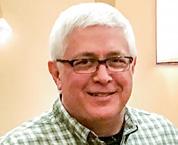
TROY MCQUILLEN is a lifelong resident of Aberdeen (except for some college time away from home) and the publisher of Aberdeen Magazine. He collects historical facts and photos, takes photos, and researches local stories rooted in legend and rumor, all in an effort to preserve Aberdeen's history for generations to come.
CHRISTINA SHILMAN is a wife, mom to an amazing little boy, mental health therapist, and owner of Paisley Tree Photography. Her photography business specializes in weddings, seniors, families, children, and lifestyle sessions. She loves capturing authentic and unforgettable moments for her clients.

ISSN
MANAGING EDITOR
Jenny Roth
PUBLISHER
Troy McQuillen

DESIGN
Eliot Lucas
AD SALES
Julie Lillis
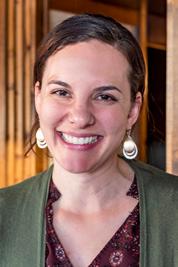
julie.aberdeenmag@gmail.com
INTERNS
Karlie Spiry
Jonah Kost
PUBLICATION OFFICE
McQuillen Creative Group 423 S. Main St., Suite 1 Aberdeen SD, 57401 (605) 226-3481
PRINTING
Midstates Printing
SUBMISSIONS
Aberdeen Magazine welcomes your input. Message us your story ideas, drop off historic photos, or stop in for a chat. Email us at: troy@mcquillencreative.com
WEBSITE
www.aberdeenmag.com
PRIVACY STATEMENT
Any personal information, email addresses, or contact submitted to the editorial office or online via our Facebook page will not be sold or distributed. Aberdeen Magazine does wish to publish public comments and attitudes regarding Aberdeen, therefore written submissions and comments on our Facebook page implies permission to utilize said information in editorial content.
Aberdeen Magazine is produced exclusively in Aberdeen, South Dakota. All content is copyright with all rights reserved. No content may be shared, copied, scanned, or posted online without permission. Please just ask us first. We’re pretty flexible.
www.mcquillencreative.com
Jenny Roth, MANAGING EDITORFor people living with dementia and their caregivers, even the simplest day-to-day tasks can be a challenge. But imagine if you could walk into a restaurant and know by seeing a certain decal on the door that their servers were trained in waiting on someone with dementia. Or imagine if other public places in your city—like stores, places of worship, and libraries, as well as law enforcement and health care systems, all were educated on recognizing dementia and being dementia friendly too. As a caregiver, you could worry a little less when taking your loved one out and about. And with this type of community-wide support, dementia patients could have a better quality of life.
The examples above are just part of what Aberdeen will be working toward in the coming years, as the city has been accepted as the first Dementia Friendly America (DFA) Community in South Dakota. What does this title mean? The DFA is a national network of communities that support people living with dementia, their families, and their caregivers in all sectors. As a member of this network, Aberdeen will be equipped with tools, resources, and guidance as it begins the process of becoming a dementia friendly city.
As aging populations increase, so often do the cases of dementia. The 2018 U.S. Census estimated that 16 percent of Aberdeen’s population was 65 and older. Recognizing the need, the Aberdeen Area Chamber of Commerce Health and Wellness Committee got the ball rolling on the DFA project, with Bethesda stepping in as a fiscal sponsor. But Lisa Anderson, director of public relations with the Chamber, says the task belongs to everyone in the community. “We have a lot of great organizations on board to be a part of this process going forward, and we’re looking for even more to get involved.” Aberdeen can expect to see educational opportunities on dementia friendliness in the near future. // — Jenny Roth
To learn more, visit the Dementia Friendly America-Aberdeen, SD Facebook page or contact Lisa Anderson at 605-225-2860.
Audra Arampatzis has built her business on providing unique and convenient experiences for her customers since day one. After graduating with her cosmetology degree in 2016, she opened AUDRA Day Spa & Salon at 18 2nd Avenue Southeast in Aberdeen. The location is the same as TM Fitness Studio, an Aberdeen staple owned by her dad, Tony Arampatzis, for over 30 years. Together, the two businesses have created a one-stop fitness studio, spa, and salon, complete with hot tubs, an endless pool, workout opportunities, and a spray tan booth.
In 2018, Audra also welcomed Wanderlust Boutique into her salon and saw how much customers enjoyed being able to get their hair done and shop at the same time. The owners of Wanderlust, Lindsey Brooks and Erin Ochsner, recently purchased Arrow Boutique on Main Street. To keep the boutique experience in her salon, Audra opened her own: Rustic Cowgirl. The store carries women’s clothing, shoes, accessories, and fitness attire in sizes XS to 3X.

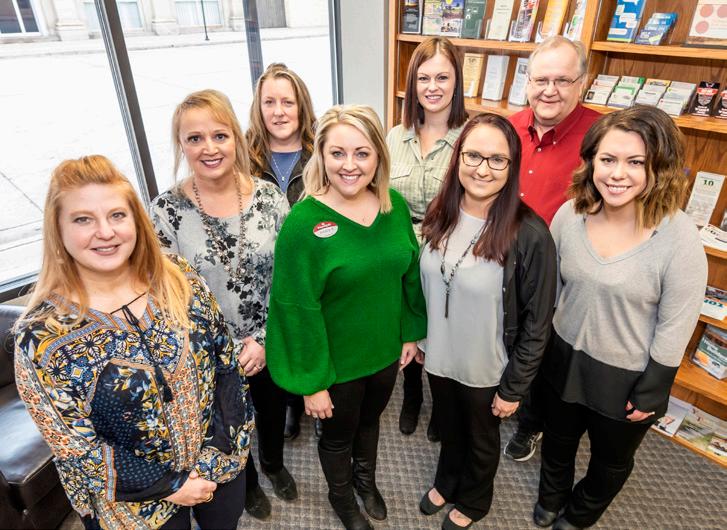
Keeping with her theme of giving customers something different than what they can find anywhere else, Rustic Cowgirl’s style is edgy, bohemian, and full of color (think Aztec and animal prints). Along with the new boutique, AUDRA is also now home to a pop-up shop featuring home decor and Swig cups from Tiffany Langer’s Pinned Workshop (322 S. Main Street). Audra says these kinds of collaborations and new ideas are what being in business is all about. “We’re trying to work together and come up with new and fun experiences for our customers.” // — Jenny Roth
To see a full list of services at AUDRA Day Spa & Salon or to book online, visit audradayspa.mysalononline.com
Who says you can’t have beautiful, blooming flowers even when it’s cold outside? That is exactly what led Grace Cutler to become a wood flower florist. Grace has always loved flowers and gardening. Growing up in Kentucky and Georgia, she would find hundreds of wildflower species and spend hours transplanting them into her flower beds. She even put together her own wedding flowers, using plants she had grown and tended herself. So it only makes sense that this Southern girl wanted to have flowers yearround while living in the more winter-esk Aberdeen. And she has found a way to do so, by creating custom sola wood flower arrangements at her business, Graceful Creations.

Sola wood is made from the root of the tapioca plant, which is grown in tropical climates in several third world countries. Once processed, the plant can be used for different types of foods, while the roots are cut and peeled into thin strips and then formed into light, slightly plyable flowers. Grace orders these from suppliers and then colors them with acrylic paint, adds greenery and a container, and arranges them to fit custom orders from her clients. People choose sola wood flowers for weddings, holidays like Christmas, Mother’s Day, and Valentine’s Day, or for home decor. The best part? They last, and if you have more of a brown thumb than a green one, you don’t have to worry. Grace explains, “They make it possible to have a wedding bouquet that keeps forever, or a flower centerpiece to match your kitchen that will always stay colorful and bright.” // — Jenny Roth
To reach Graceful Creations, visit www.facebook.com/gracefulcreationsGC or text 605-545-3293.

Helping a coworker has turned into an unexpected but fulfilling business for two Aberdeen friends. Dave Zimmerman and Rob Rott work together at 3M. The
company often holds fundraising raffles to assist employees with family emergencies or illnesses. Since they had both been detailing cars for years, Rob on his own vehicles and Dave while working for an auto dealership, they decided to donate a free car detail to one of these raffles for another coworker. That was back in April. Fast forward to today, and their Z & R Auto Detailing now has its own shop and has been booked almost nonstop with cars,
Dave and Rob work around their 3M shifts, offering both morning, evening, and Saturday detail appointments with free pickup and delivery. To keep their menu simple, no matter what condition or size of the vehicle, a complete interior and exterior detailing is always $200. Rob adds, “We only work on one vehicle per day so we make sure it gets done right.” They admit to being picky, which is a good thing when the details matter. Along with cleaning everything, they do extra things like buff out any scratches, wash the engine, and fix rock chips.
Detailing cars is a part-time gig, but one that Dave and Rob plan to keep long term. They both love being around cars and are finding the more they work on them, the more they enjoy it. Dave says their favorite part is the reveal and seeing how excited people get about their vehicle’s transformation. “That’s our goal, to make your car look better than when it was new.” // — Jenny Roth
Z & R Auto Detailing is located at 2821 8th Avenue NE. You can contact them via their Facebook page or by calling Dave at 605-380-7340 or Rob at 605-252-6259.

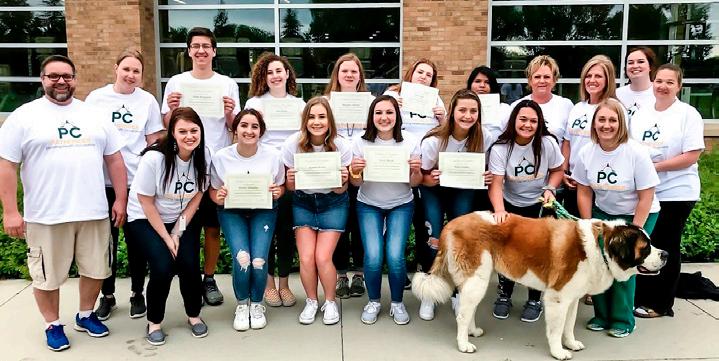
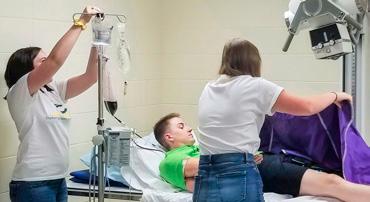

So often college students choose an area of study, take intro classes for that major, and then get real-life work experience in their field later on. But Presentation College shakes up that traditional order with their PC Pathfinder Camp, giving high school students the opportunity to be immersed in at least eight healthcare professions before they even get to their first year of college.
The purpose of the camp is just like the name implies: to help students get on their ideal career path right away, so they can avoid having to switch majors and can instead take the classes that are the most meaningful to them from day one. Sometimes students know they want to work in healthcare, but aren’t aware of the whole gamut of possibilities they can study. Trisha Waldman, associate dean of health and science at PC, explains, “Students get to see the different healthcare programs and find out what their interests are, and they are introduced to programs that they might not have even realized were options.”
During the three-day camp, sophomores, juniors, and seniors spend part of the time touring healthcare facilities and hearing from a panel of healthcare professionals. The rest of the time is dedicated to hands-on experiences in several fields, including nursing, exercise science, human services, psychology, radiologic technology, biology with a pre-med focus, and healthcare administration. PC faculty from each of these areas work directly with the students, teaching them skills and even guiding them through mock healthcare simulations. The camp also gives students a chance to experience college life. They get to interact and eat meals with PC’s faculty and stay at PC’s student suites. // — Jenny Roth
PC Pathfinder Camp takes place June 22-25, 2020. The cost is $100 and includes lodging, meals, learning, and one college credit toward an Intro to Health Occupations class. Registration is open now at mypc.presentation.edu/pcpathfinder.
The fire that took their building this past October was a setback for Malchow’s Home Furnishings, but not the end. Today, they have a new location on Main Street and are serving customers in Aberdeen as they have been for almost 75 years.
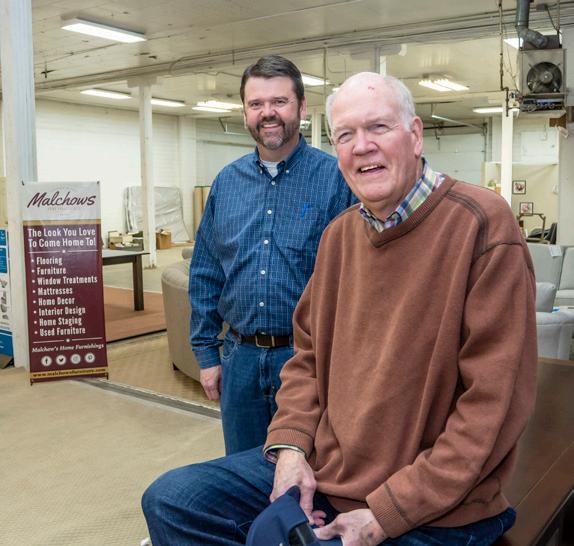
Humbled and overwhelmed. Those are the two words that come to mind for Mark Malchow, thirdgeneration owner of Malchow’s, when he thinks of the support his business has received in the last few months from the Aberdeen community. While saying goodbye to a building that carried memories dating back to 1945 has been difficult, it hasn’t meant saying goodbye to their family business too. Mark says, “We’ve had so much support from Aberdeen for us to come back from this and keep providing our services here. Small businesses are asked to give a lot to the community, and we’ve always done that. But when you go through something like this and it all comes back to you tenfold, it truly puts it into perspective what kind of a community Aberdeen is. We’re very proud to be a part of it.”
Malchow’s is open Monday through Friday from 9:00 AM to 5:00 PM at their new office at 309 South Main Street. Customers are welcome to stop in or make an appointment to visit their warehouse, where they have furniture, home accents, window treatments, and flooring inventory and samples on hand. They are also working more mobile, bringing samples right to their customer’s homes. “We’re doing everything we did before the fire, just a little bit modified,” Mark says. // — Jenny Roth
To reach Malchow’s Home Furnishings, call 605-225-1900, visit www.malchowsfurniture.com , or find them on Facebook at www.facebook.com/malchowsfurniture
WINGS HOCKEY HOME GAMES
January 10, 17 & 18
February 7 & 8, 21 & 22, 7:15 PM
Odde Ice Center
Cheer on Aberdeen’s junior ice hockey team. Tickets available at the door. www.aberdeenwings.com

LITTLE TEXAS
January 18, 7:00 PM

Dakota Event Center
Live country and country-rock music concert. Tickets at Kessler’s, Mavericks, or www.dakotaeventcenter.com


SOUTH DAKOTA JAZZ FESTIVAL CONCERT
January 23, 6:00 PM - 9:00 PM
Johnson Fine Arts Center
Nationally acclaimed trombone player and vocalist Aubrey Logan joins the NSU Jazz Band for an evening of live jazz music. Tickets at www. aberdeencommunityconcerts.org
OPEN 8 BALL TOURNAMENT
January 24-26, 10:00 AM - 4:00 PM
Best Western Ramkota Hotel
Eight ball singles and team tournament sponsored by the Aberdeen Cue Club. Reserve a spot on the event’s Facebook page.
CITYWIDE YOGATHON
January 25, 9:00 AM - 3:00 PM
Various locations in Aberdeen
YOUNG ARTIST COMPETITION

January 11, 9:00 AM - 6:00 PM
Northern State University
For high school juniors and seniors, a chance to win music scholarships and cash prizes in piano, strings, voice, and wind/ percussion categories. Visit www.northern.edu/youngartist-competition
BUILD A BOWL
January 25, February 8 & February 22, 10:00 AM - 12:00 PM
Aberdeen Recreation and Cultural Center
Craft a ceramic bowl for the Empty Bowls fundraiser. RSVP by calling the ARCC at 605-626-7081. Free event.
ABERDEEN ROYAL PRINCESS BALL
January 26, 12:30 PM - 3:00 PM
Dakota Event Center
Bring your youngest princess fans for a meet-and-greet with their favorite princesses. Dancing, stories, stage performances, and picture opportunities. Tickets at www.eventbrite.com
Aerial yoga, chair yoga, or yoga with shopping and wine?
You can find all of the above at the citywide Yogathon. Donationbased with proceeds going to NAMI. Call Profiling Beauty at 605-290-4947 for details.
HUB CITY RADIO’S 2020 BRIDAL SHOWCASE
February 16, 12:00 PM - 3:00 PM
Dakota Event Center
Everything you need to plan the perfect wedding under one roof. Visit www.hubcityradio.com
BOYS & GIRLS CLUB
BANQUET
February 21, 6:30 PM - 8:30 PM
Dakota Event Center
A fundraising event featuring six-time Olympic medalist Jackie Joyner-Kersee as the keynote speaker. For tickets call 605-2258714;104

SAFE HARBOR MARDI GRAS
February 1, 5:00 PM
Ramkota Convention Center
Specialty martinis by Paul Weiss, Venetian face painting, dinner,casino games, silent auction, and music entertainment. Tickets at www.safeharborsd.org.
February 2, 9:15 AM - 3:00 PM
The Village Bowl
Open to anyone with a current USBC youth membership. Hosted by JST of South Dakota (a youth bowling tour that hosts tournaments). Call 605-229-4800 for details.
BINGO AT ONE-LEGGED PHEASANT
Wednesdays, 7:00 PM - 8:00 PM
One-Legged Pheasant Brewery
Win beer and a chance at the prize pot. $1 per ticket. For deatils call 605-725-1534.
TRAVELING CHILDREN'S EXHIBIT

February 8 - May 8
Dacotah Prairie Museum
Learn about tree habitat, animals and insects that live in trees, and more in this temporary "TreeHouses" exhibit. Free admission. Details at dacotahprairiemuseum.com.
JAMI LYNN TRIO
February 8, 7:00 PM
ARCC Library Auditorium
Bluegrass and folk music concert with South Dakota native and singer/songwriter


Jami Lynn. Tickets at AberdeenAreaArtsCouncil.com

FISCHGAARD SHORT FILM PROJECT

February 14-16
Capitol Cinema
Filmmaking teams create a movie four to seven minutes in length in just one weekend. The Filmmakers kickoff event is February 14 at 5:30 PM at the Red Rooster. Public viewing of the films is February 16 at 6:30 PM at the Capitol Theatre.
ABERDEEN UNIVERSITY-CIVIC SYMPHONY CONCERT
February 29, 7:30 PM
Harvey and Cynthia Jewett Theater, JFAC
AUCS presents “Unfinished Business,” featuring works of great composers who didn’t complete their masterpieces for one reason or another.
For tickets visit www.aberdeensymphony.org or call 605-626-2900.
PRESENTATION COLLEGE BLACK & WHITE BALL
February 29
Dakota Event Center
Fundraising gala to support student scholarships at Presentation College. Cocktail hour, dinner, and Avenger Joe concert. For seats call 605-229-8454.

ABERDEEN AG EXPO
March 3,4 & 5 Holum Expo Building, Brown County Fairgrounds
The area’s only show designed with local farmers in mind. For info contact Dakota Broadcasting Studios at 605-725-5551.
Aubrey Logan Avenger JoePotter Nicole Volk is accomplishing something most adults never actually get around to doing. She is living out one of her childhood dreams and loving it every minute.
 by JENNY ROTH
by JENNY ROTH
Growing up in Lake Preston, Nicole Volk wanted to learn how to make pottery. An unusual dream, perhaps, for an elementary student living in a rural South Dakota town whose population just barely squeaks above 500. But when Nicole was a kid, nearby Arlington, South Dakota, (population about 850) was home to a pottery studio called Arlington Pottery. Every summer, they chose one high school apprentice to help with shop duties, and more importantly, to learn the art form firsthand. Nicole bided her time until she was old enough to apply for the apprenticeship, but sadly, the shop closed before she made it to high school. Still, the dream of learning pottery didn’t quit. And when she moved to Aberdeen to study music education at Northern, she kept it in her future plans. “It was still something I had in the back of my mind that I wanted to do, so I thought maybe if I teach during the school year, then I could still have time in the summer months to learn pottery or do art shows,” she says.
When her sophomore year at NSU rolled around, Nicole decided if she didn’t take a pottery class now, it might never happen. So she made the leap and signed up for a semester. Was finally getting to learn pottery worth the long wait? “I absolutely fell in love with it,” she says. “I ended up
taking four semesters of pottery and graduating with an art minor.” She credits her professor at NSU, Mark Shekore, for furthering her love of the craft even more. “I learned so much from him, and we have very similar styles. I think when you study under someone, you naturally pick up some of their isms too.” She adds that Professor Shekore was influenced by one of her favorite potters of all time, the famous Simon Leach, and they both inspire the rustic, functional pieces she creates at the wheel today.
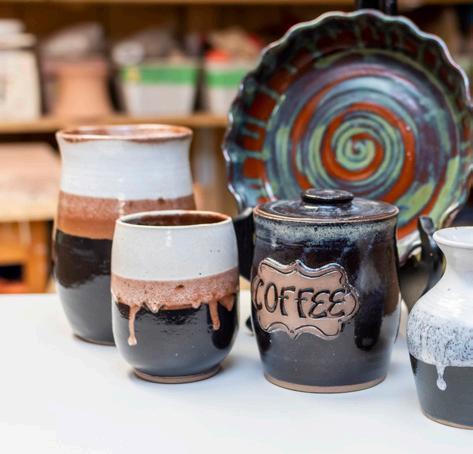
After graduation, Nicole became busy with a full-time job and a family, which didn’t leave a lot of time for crafting pottery. Later on, when she was ready to get back into the swing of making things, she found a kick wheel at a surplus auction in Aberdeen. Using a kick wheel, a potter literally propels a heavy stone or concrete base with their foot, spinning it manually while also using their hands to shape the clay. Nicole has since transitioned to an electric wheel but is glad to have first learned using a kick. She laughs, “If you can throw a pot while keeping your legs moving, using an electric wheel seems that much easier.”
Nicole didn’t immediately start taking custom orders or attending art shows after she picked up pottery again, but instead took her time relearning the skill. Now, it’s
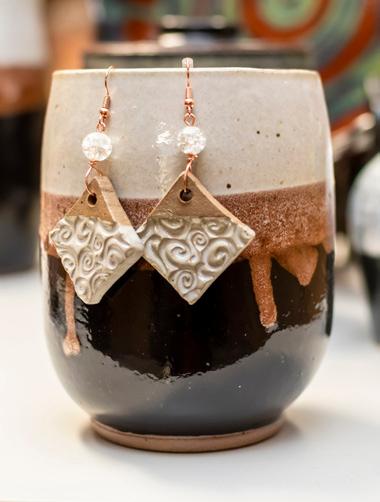

been about three years since she launched her part-time pottery business. She still works full time, as an academic advisor for online nursing students at Presentation College, and mostly sits down at her wheel in the evenings after her daughters, Jada (10) and Maci (4), are asleep for the night. “My daughters are a bit older now, and they love to throw pots with me and have some of their own pieces they’ve made on the wheel too. I’m excited to see where they go with it,” she says.
Everything Nicole makes is functional art. Mugs are her favorite. “There’s something about drinking coffee out of a mug that someone hand-formed. You can see the fingerprints that go into it sometimes where the throwing lines are, and you know somebody specifically made that, instead of it being poured out of a mold,” she says. Also growing in popularity is her clay jewelry, including earrings and bracelet pendants. “Even though they’re made out of clay, they’re very, very light. It’s fun to combine them with different colors and beads,” she says. For her, it’s important to make art that people can use as well as enjoy. When she and her husband Nick were first married, they lived in a 600-square-foot home, so everything in it, even the art, had to have some kind of functionality. She says, “I think a lot of people can relate to that. They love art, but they don’t have space for big sculptures or for big paintings on their walls. But they do have room for it on the coffee cup they take to work every day.”
Nicole creates custom orders for her clients as well as travels to a few art shows every year with her work. What do most people say when they see her at the pottery wheel? “‘Can you teach me?’ That’s the number one comment I hear,” she laughs. So maybe the dream of being a potter in rural South Dakota isn’t so far-fetched, but she admits having an art career in a small town does pose its own challenges. It’s not as easy to get your name out there, and often you have to drive long distances to meet customers or attend shows. On the other hand, she adds there is plenty of support here from artists who have made it work before, along with online pottery groups where members share their tricks and techniques. While learning from others, she has also become an artist to learn from, and proof that no matter where you live or how little time you have, you can craft your own creative life. //
WEIN GALLERY
Presentation College
1500 North Main Street 605-229-8349
Mon-Fri 8 AM-5 PM
PRESIDENT’S GALLERY, JFAC GALLERY AND STUDENT CENTER GALLERY
Northern State University
1200 South Jay Street
605-626-7766
President’s Gallery: Mon-Fri 8 AM-4:30 PM, JFAC Gallery: Mon-Fri 8 AM-4:30 PM, Student Center: Mon-Fri 7 AM-4:30 PM and weekends 1-9 PM
LAMONT GALLERY
Dacotah Prairie Museum
21 South Main Street
605-626-7117
Tues-Fri 9 AM-5 PM, Sat and Sun 1-4 PM
ARTWORKS CO-OP GALLERY
Aberdeen Mall
3315 6th Ave SE Suite #48 605-725-0913
Thurs-Sat 11-6 PM & Sun 12-6 PM or by appointment
JANE WEST GALLERY
Capitol Theatre
415 South Main Street 605-225-2228
Open during events, call ahead for additional hours of operation
ARCC GALLERY
Aberdeen Recreation and Cultural Center 225 3rd Ave SE 605-626-7081
Mon-Thurs 9 AM-8 PM, Fri 9 AM-5 PM and Sat 10 AM-12 PM
RED ROOSTER COFFEE HOUSE
GALLERY
218 South Main Street
605-225-6603
All of Nicole’s pieces are meant to be both enjoyed and useful. So even if you don’t have a lot of space for art in your home, you can still include it on your everyday objects.
To reach Nicole Volk, call 605-380-2116, email nicole_volk@hotmail.com , or visit facebook.com/ nicolevolkpottery.
Mon-Thurs 7 AM-7 PM, Fri 7 AM-9 PM and Sat 8 AM-9 PM Sun 9 AM-2 PM
Along with coffee mugs, Nicole crafts lightweight clay earrings and jewelry pendants.“‘CAN YOU TEACH ME?’ THAT’S THE NUMBER ONE COMMENT I HEAR.”
It’s a Tuesday afternoon at Kids Against Hunger Aberdeen and Phyllis stops sorting merchandise for only a beat, just long enough to glance at her step counter before she keeps on moving. “You won’t find too many people who enjoy their job as much as I enjoy this one. Every day is different and there’s always something to do,” she says. Nearby, Tony organizes a recent donation, while Jackie hangs clothes on racks according to size. At the cash register, Carol helps a family purchase items for their home. All the while, shoppers mill about, browsing through used clothes, glassware, furniture, toys, electronics, and books.
Phyllis, Tony, Jackie, and Carol, along with LeaAnn, Sylvia, Sherri, and Kary, are working to keep Kids Against Hunger Aberdeen’s doors open. The nonprofit was born out of a vital but often uphill mission:
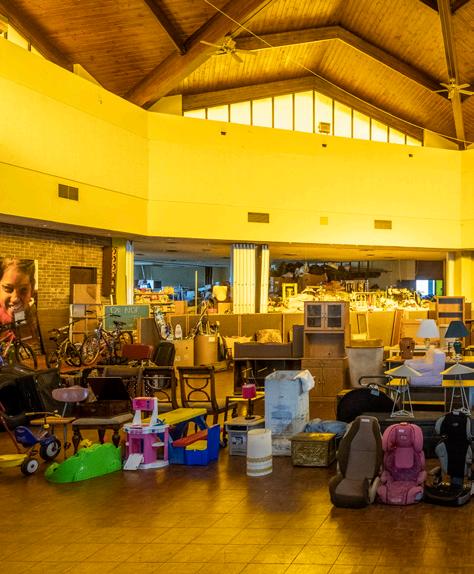
to feed the most impoverished and hungry children in the world. Richard Proudfit, a Minnesota native and the founder of Cardinal Tool, started Kids Against Hunger as well as another nonprofit called Feed My Starving Children. Together, both organizations have provided billions of meals to children and families. Sadly, Richard passed away in 2018, but not before getting Kids Against Hunger sites up and running all over the U.S. and Canada. The Aberdeen location upholds Proudfit’s tireless spirit and effort to do good. Sherri and LeaAnn will drive by the store multiple times every evening to make sure any donations left outside get moved in. If a group wants to package food even on a day they are closed, they’ll make it happen. And families who come to the thrift store not to shop, but for assistance, are never turned away.
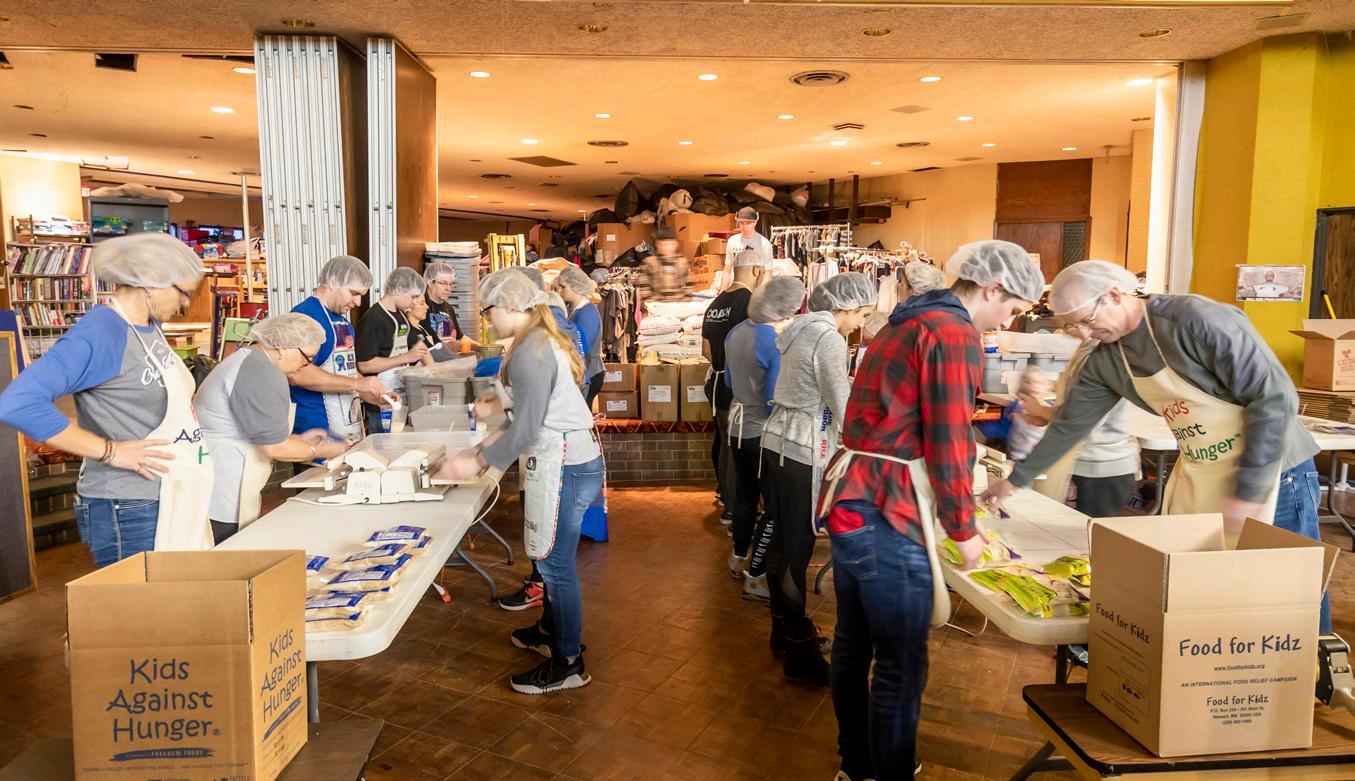
At Kids Against Hunger Aberdeen, volunteer groups can sign up for two-hour shifts spent packaging vitamin-rich soy rice meals that can be prepared anywhere by just adding boiling water. Then, the meals are shipped to wherever there is the most need. Each group also donates or raises money to cover the cost of the food. Churches, 4-H clubs, and families are just some examples of those who have packaged food in Aberdeen so far. While most meals used to be sent overseas— to countries like Haiti, Honduras, and Guatemala, now almost all are given to local churches and families. South Dakota’s Convoy of Hope charity will pick up meals and deliver them around the state at no charge to Kids Against Hunger.
After running successfully for the first couple of years, Aberdeen’s food packaging center faced a decline in numbers and a possible closure. That’s when employees and volunteers started brainstorming ways to keep it open. They hosted rummage sales, became a rummage sale drop-off site, and eventually evolved into a fullystocked thrift store. It is now the only Kids Against Hunger location with a thrift store and it serves its primary purpose: to keep the food packaging center going.
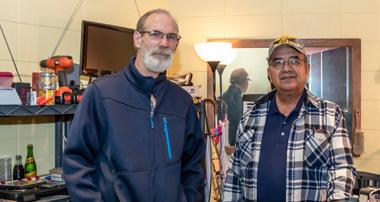
Kids Against Hunger Aberdeen wants people to know they are open. Tucked behind the Village Bowl, directly west of the Lee Park Golf Course in the former Elks Building, they often get overlooked by passing traffic. Their thrift store welcomes shoppers and donated items Tuesdays, Wednesdays, Thursdays, and Saturdays from 10:00 AM to 5:00 PM, and if you
have a group interested in packaging food, just give them a call at 605-262-4444 to set up a time. Sherri says for the future of Kids Against Hunger, they’d like to see more young people involved. That has been the goal all along, to give kids a place where they can help other kids. “All ages can do the food packaging. Sometimes the fundraising part of it can scare people away, but even if every person who packages donates just $25, that is all it costs for us to order the food. And in just two hours, a group of eleven can put together over 4,000 meals. It’s an amazing thing to teach your children and it gives them that sense of being a part of something bigger and being able to help others,” she says. //
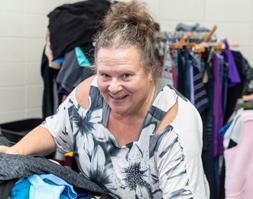
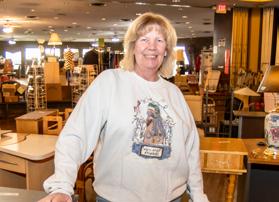

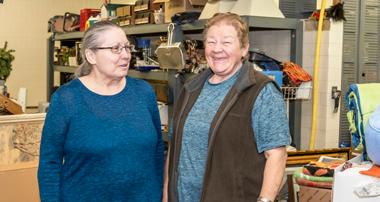
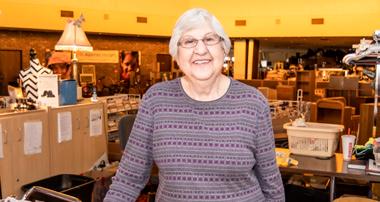
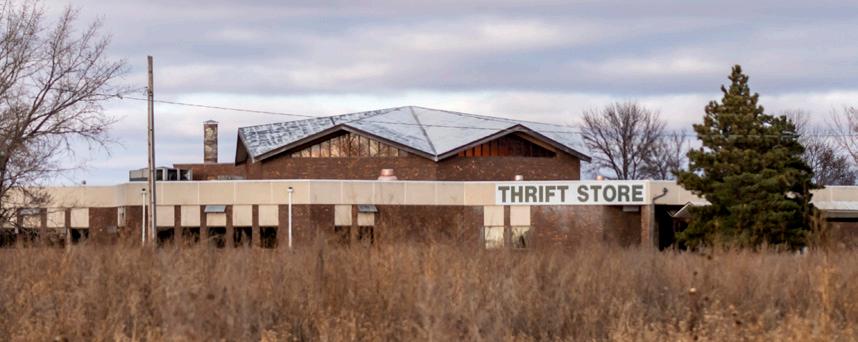
Kids Against Hunger Aberdeen is located at 1121 Olive Drive. To learn more, find them on Facebook or visit www.kidsagainsthungeraberdeensd.org.

If you’ve ever wondered how your family can make a big difference in the bigger world, look no further than Kids Against Hunger
Aberdeen by JENNY ROTHPhotos by Troy McQuillen Kids Against Hunger Aberdeen is located at 1121 Olive Drive, just north of the Village Bowl.
It still brings tears for Cindy Kirschman when she remembers watching her teenage grandson suffer from anxiety. One of the most difficult parts, she says, was just not knowing what she could do. Anyone who has lived with mental illness or loved someone who does knows that helpless feeling. If someone has cancer, a broken bone, or is recovering from surgery, neighbors and friends surround them with flowers, well wishes, and homemade casseroles for the freezer. But as the saying goes, mental illness isn’t a casserole sickness. The acceptance you receive compared to having a physical illness isn’t always the same. And while the stigma around mental health has come a long way, there is still a lot of work to do.
When searching for answers, Cindy discovered NAMI, the National Alliance on Mental Illness. There are over 650 NAMI Organizations in the U.S., and eight NAMI chapters in South Dakota alone. As Cindy began attending their conferences and finding support for her family, she says she knew NAMI was something we needed in Aberdeen too. So a group was organized and in 2016, NAMI Aberdeen officially became active in the community. Out of its 15 or so members, everyone is a volunteer,
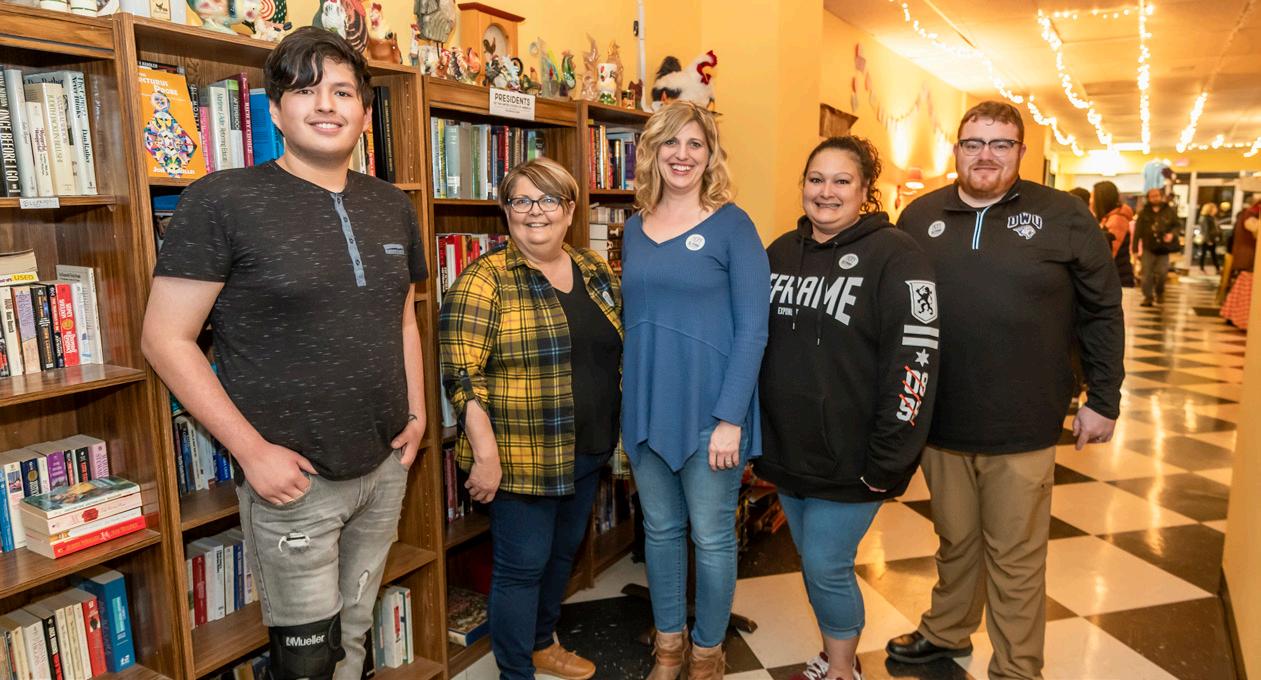
and almost everyone has either lived with a mental illness or has a family member who does. Amy Sanderson, clinical director at Northeastern Mental Health Center, is the only mental health professional in the group. Cindy is quick to credit Northeastern Mental Health for being a strong support for NAMI, but Amy is just as quick to mention how important it is to have groups like NAMI that get involved with mental health issues at a community level. She says, “They are instrumental
in fighting the stigma because they show people it’s okay to tell their story, and it’s okay to reach out for help because here are real people who live in your town who are doing that, so you’re not alone.”
At its core, NAMI Aberdeen has three main goals. The first is to educate the community. Cindy says, “We want to erase any misunderstandings and replace those with correct information about mental illness and recovery.” To do this, Aberdeen volunteers have so far completed the necessary training to host two NAMI programs, NAMI Basics and Ending the Silence. Basics is a six-week course for parents and caregivers of children who have mental health challenges. Last fall, seven caregivers participated and learned about medications, how the brain functions, and other important topics like how to communicate with schools and why your child’s illness is not your fault. Cindy adds, “The people teaching the class have all been through it, so a really good bond forms among all the parents.” Ending the Silence is an hour-long program created for a student audience. During the program, a young person living with mental illness shares their journey of recovery. Another part of education is connecting people to mental health resources in the community.
NAMI Aberdeen is providing a safe place for everyone in the community to talk about mental illness.
Amy says it’s about breaking down barriers that commonly get put up around getting help, such as fears about being able to afford it, that don’t really exist. “We have a lot of resources in the Aberdeen area, it’s only a matter of figuring out how to tap into those, and NAMI can help with that.”

NAMI’s second goal is to reduce the stigma around mental illness. Amy says, “We get out into the community wherever we can—at health fairs and other city-wide events, to spread the word and be open about the issue of mental illness.” Both she and Cindy agree that the more we talk about mental illness, the more it becomes just like any other health condition and not something to be ashamed of. “Mental illness can be just as disabling as a physical illness in terms of lost productivity at work and lost ability to make connections with your family and function like you normally would, so it should be treated with the same response,” Amy says.
The third goal that ties everything together for NAMI Aberdeen is to provide support groups and meetings. Their Family Support Group, which meets the second Monday of every month, is for family members who are seeking help in understanding what their loved one is going through. Amy says, “It’s unique because it’s the only place in Aberdeen that I know of where you can get direct, free support and meet other families who are going through the same thing you are.” Cindy adds, “You’ll find you’re not alone, and you’ll learn from one another how to love someone and care for someone with a mental illness.” Along with Family Support, they also have Connections, their support group for adults living with mental illness, which meets twice a month. In addition, they have an Affiliate Meeting and a monthly NAMI Night, which is open to anyone who wants to learn more about the organization and how they can become involved.
With all of these programs and activities, NAMI wants to continue to grow even further. In September, Aberdeen will host hundreds of people for the annual NAMI South Dakota Conference. And they are always looking for more volunteers for their Ending the Silence Program and also those who can share their hobbies, skills, or professions as part of NAMI Night. Amy concludes, “The most important thing is that it gives people a place where they can talk about mental issues and know that it’s okay to do so, and that they have support.” // If you are interested in a program hosted by NAMI Aberdeen or in learning more about the organization, visit www.namisouthdakota.org or contact Amy Sanderson (605-225-1010) or Cindy Kirschman (605-380-0053).
ABERDEEN AFFILIATE MEETING
3rd Monday of the month
5:30-7:30 PM
Northeastern Mental Health Center
➼ For anyone interested in learning about NAMI.
FAMILY SUPPORT GROUP
2nd Monday of the month
6:30-7:30 PM
Bethlehem Lutheran Church
Fireside Room (west door)
➼ For family members with a loved one with mental illness.
CONNECTIONS SUPPORT GROUP
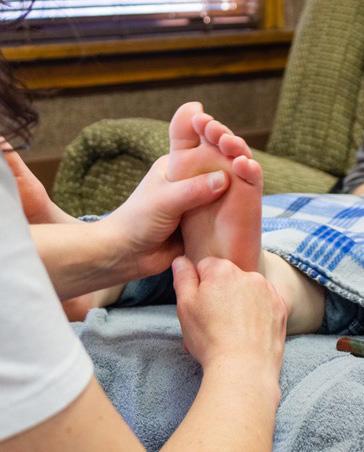

2nd and 4th Wednesday of the month
6:00-7:00 PM
Caribou Coffee, (location subject to change, call 605-380-0053)


➼ For adults living with mental illness.
NAMI NIGHT
One Saturday/month, call 605-380-0053
Red Rooster Coffee House
➼ Open to the public, monthly wellness activity/entertainment.

Ella Huettl feels at home when she is on stage. At only 12 years old, she has already been singing the National Anthem at various events in Aberdeen and the surrounding area for over three years. And we’re not talking about just singing a handful of times. Her mother, Jennifer Huettl, estimates Ella sings the National Anthem at over 50 different occasions every year. Along with singing, her next love is sports. So it’s not unusual for the seventh-grader to kick off a Wings hockey game or Northern State basketball game by singing the National Anthem, and then head to her own basketball or volleyball match within the same evening. With more than a few performances on her resume, nerves are mostly a thing of the past. “I was a little bit nervous the first couple of times I sang in public, but that part has worn off now,” she says.

Ella’s singing career began when she started memorizing the National Anthem after hearing her older sister perform the song. Then one day, Jennifer says she happened to overhear Ella singing at home and was so impressed that she recorded her and sent the clip to her teacher, who in turn connected Ella with another student who was doing the National Anthem around town. It only snowballed
SCHOOL: Simmons Middle School, 7th Grade
FAMILY: Parents Jennifer Huettl and Les Huettl, sister Alexis, brothers Dawson, Hudson, and Quinn, and nephew Aidyn
FAVORITE ACTIVITIES: Singing, gymnastics, volleyball, basketball, hunting, and guitar
FAVORITE SINGER: Carrie Underwood and Ashley McBryde
ROLE MODELS: God, my mom, my sister, and Carrie Underwood
FAVORITE SCHOOL SUBJECT: Science, gym
from there. That same year, Ella sang at her first public event, the Lincoln Day Dinner at the Dakota Event Center. Soon after, she got a call from the Wings to sing at one of their home games. To this day, the crowd at the Odde Ice Center is one of her favorites. “I love being in the spotlight on the ice with all the hockey fans there,” she explains. Her most massive crowd, though, was at a youth state wrestling tournament at the Barnett Center, where she sang the National Anthem in front of 5,000 athletes and their families. She also sings at car and horse races, rodeos, conventions, fundraisers, and the Special Olympics, to name a few places. A country girl at heart, one of her biggest goals is to someday sing in Nashville. She would also like to perform the National Anthem at a Minnesota Twins game in memory of her great-grandfather, who both loved the Twins and hearing her sing. To get there, she takes weekly vocal lessons from musician Ron Parker and is learning to play the guitar. Whether in Nashville or Aberdeen, it’s easy to see that Ella’s talent for music is something she will carry with her for a long time. She says, “What I like most about singing is that you can choose a song based on whatever feelings or emotions you want to express, and then share that with others.” //
2017 Brown County Fair Rising Star Youth Division Winner
2018 Miss Aberdeen Junior Talent Winner
2018 Talent Finalist at South Dakota Junior Snow Queen

2019 Blues, Brews, & BBQ Talent Show Jr. Division Winner
2019 Second Place at the South Dakota State Fair Jr. Talent
by JENNY ROTHIf you’ve been to any athletic event in Aberdeen, there’s a good chance you’ll recognize National Anthem singer Ella Huettl.

Surrounded by windows that let in plenty of natural light sits a cozy living room full of gliders and rocking chairs. The fireplace takes up one corner of the room, fit snugly between a shelf full of books and a door leading to the garden and gazebo. Close by are the kitchen and dining room, with bedrooms just down the hall. If you feel like you have just walked into a house, it’s because you have— Angelhaus, to be exact. At any given time, it is home to about 16 senior residents. It was designed to feel very homey, but also to be very functional in providing care. Centered in the middle of everything is a nurse’s station. At least two people are on staff here 24 hours a day, seven days a week.
by JENNYSo what exactly is Angelhaus? A nursing home? An assisted living? Technically, the answer is the latter. However, as owner Nathan Gellhaus puts it, they are an assisted living plus. That plus he refers to are the nine optional, state-licensed services they have opted to give their residents, some of which include memory, oxygen, diabetes, incontinence, and hospice care. Traditionally, people will live in an assisted living until their health no longer allows it and they have to move into a skilled nursing facility. Angelhaus is different because they strive to take care of each of their residents for the remainder of his or her life.
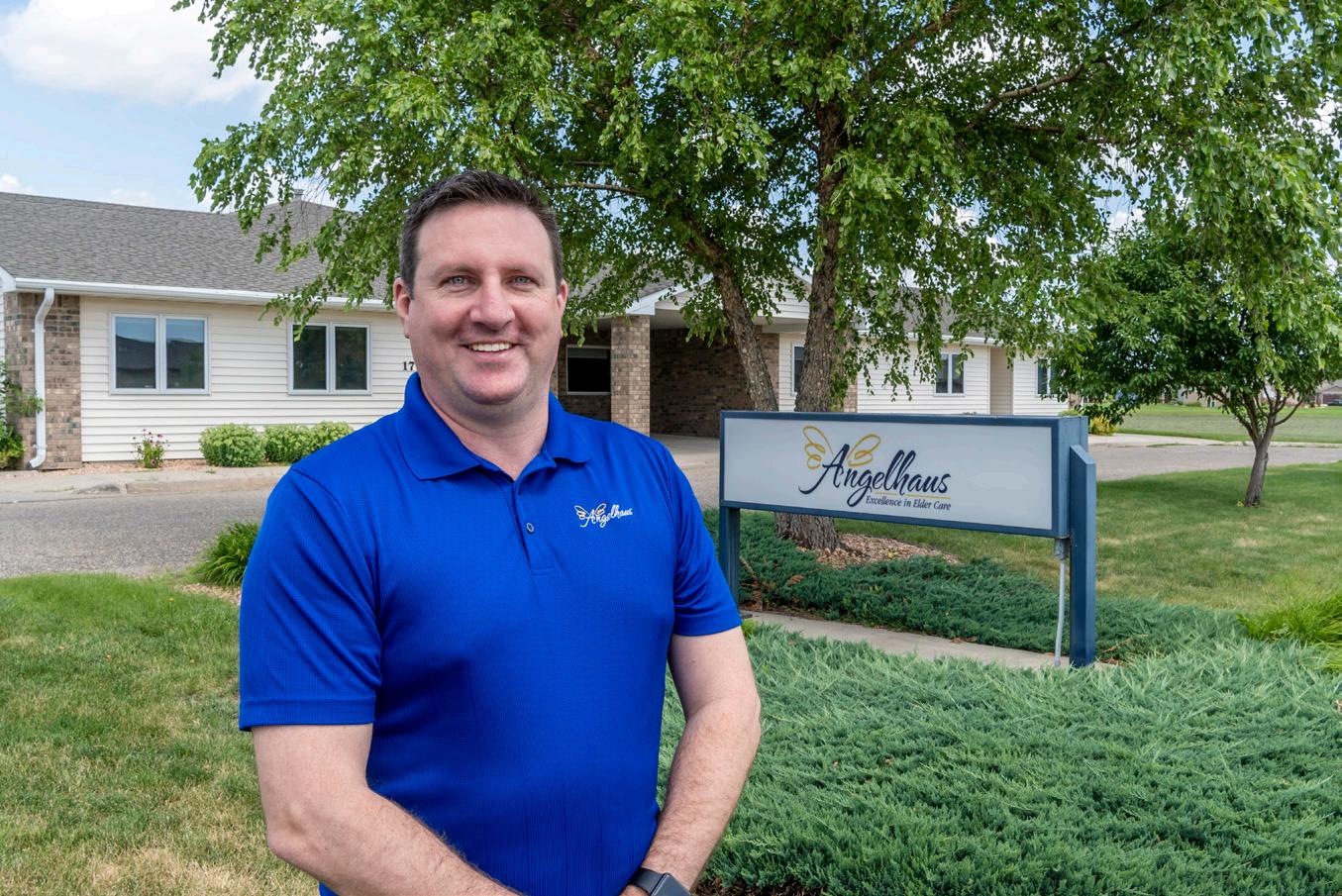
In South Dakota, trending in everyone’s news feeds are reports on how rural nursing homes are closing, while healthcare costs
continue to rise far beyond the covered reach of Medicaid reimbursements. Caring for seniors also comes with a lot of regulations, a lot of unpredictability, and a lot of competition. In Angelhaus’ case, these challenges are evenly matched up against an entrepreneur who has weathered his fair share of business ups and downs. But before we talk about Angelhaus today, it’s important to know the beginning of their story.
In the early 1990s, Ken and Marilyn Gellhaus were driving across the country to visit family. A stop at her brother’s house in Idaho ended up not only changing their lives, but the way the entire Aberdeen community would look at senior caregiving. Her brother and his wife, who was a nurse,
How one Aberdeen family is changing everything you know about senior living.
ROTH Owner Nathan Gellhaus stands outside Angelhaus (Melgaard Road), an “assisted living plus” in Aberdeen that offers a personal model of senior care.
lived on the second floor of their house and took care of four individuals who lived on the main level. Marilyn saw how they made meals, helped manage medications, and provided a safe and sociable environment for their tenants. On their drive back home, she decided she was going to do the same thing as her brother and sister-in-law. So at 62 years old, she did. Why would someone who had just reached their retirement take on something so big? Because caring for people was one of Marilyn’s gifts. About his grandmother, Nathan says, “She raised four boys and was always going, going, going— nonstop. I think this kind of thing appealed to her because she was always so thoughtful, always an amazing caregiver, and always cooking the most wonderful food from scratch. She was 62, but she still had so much life in her and she knew she could do this.”
Soon after returning to Aberdeen, Ken and Marilyn built the Gellhaus Carehaus on 13th Avenue. Half of the home served as their living quarters, and the other half was set up with enough rooms for six senior residents. Just like that, the initial Angelhaus was born. While today they

provide a higher level of care, in those early days they served people who were new to senior living, serving them good meals and hosting activities. It didn’t take long for the Gellhaus Carehaus waiting list to grow. A few years later, Ken and Marilyn’s son Dennis moved back to Aberdeen and opened Gellhaus Carehaus 2 at 1005 North Redwood Lane. Today, that nine-bedroom home is a licensed assisted living known as Angelhaus North.
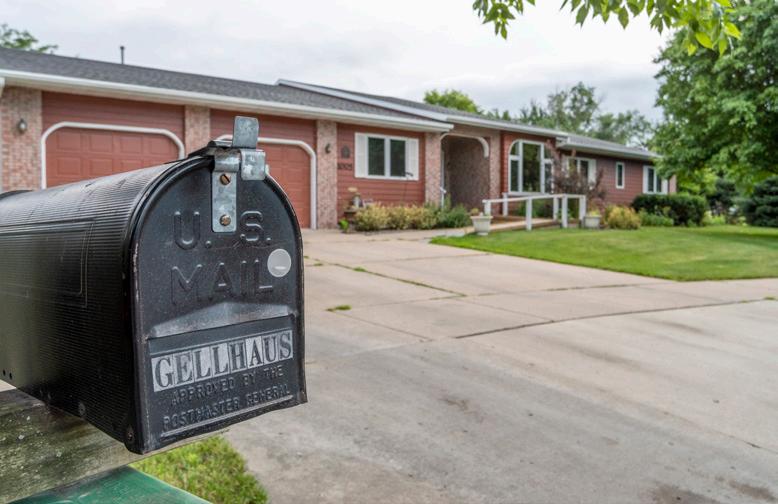
Angelhaus’ east location on Melgaard Road came to be a few years later in 2000. At a golf tournament held in memory of his brother, Dennis met Clara Noles, a soon-to-be retired director of nursing with 25 years of experience in her field. Together, they created the vision of what Angelhaus is today—a place that bridges the gap between residential and nursing home care and provides enough services to care for residents for the rest of their lives. Nathan explains, “At the time Angelhaus was getting started, this was a budding concept. There were not many assisted living facilities in South Dakota.”
Clara managed Angelhaus until Nathan took over a decade later. Just months after
he purchased the family business, a survey by the Department of Health determined that seven of their 16 residents were above the level of care of an assisted living and therefore had to move out. The State was also undergoing large policy changes at the time, making the boundaries between assisted livings and nursing homes clear where they had once been more blurred. This was a devastating blow to Angelhaus, both emotionally and financially. Nathan says, “We knew—and the families of our residents knew— that we were capable of providing the care for our people that we had always done. For the State to come in and say that we couldn’t run our business that way — it was like a perfect storm.” But instead of giving up, they went to the state legislature and the governor, writing and advocating a bill that would allow an assisted living to provide more services. Eventually, they were successful and granted the ability to offer dining assistance and two-person transfers to residents, two services that were previously reserved only for nursing homes. “It was a long fight but we preserved the Angelhaus care model,” Nathan says.
With 16 beds at one site and 11 at the other, the staff at Angelhaus, who are all trained and certified nurses and nursing assistants, can spend more one-on-one time with each resident. Nathan speaks highly of his roughly 40 employees. “They are great. We can take the time here. It’s not one aide for every 16 people, it’s four aids taking care of 16 people, so things are not as rushed.” He continues, “We provide a very high level of healthcare, comparable to a nursing home, but we do it for significantly less and with a more family-oriented atmosphere.” According to Nathan, the average cost to live in a traditional assisted living in the area is usually about $3,000 to $5,000 per month, and the average cost of a nursing home stay in a private room starts at about $8,000 per month. Angelhaus’ monthly rate is around $5,800. All of their residents are private pay.
Nathan says Angelhaus was the first stand alone assisted living in the state to provide the nine optional services that they do, and that there is nothing like them anywhere else in South Dakota. “We are way more than an assisted living, we are essentially a nursing home alternative. That is the model we have always had and will always work to keep.” //
To learn more about Angelhaus, visit www.angel.haus or call 605-725-7777.
Marilyn Gellhaus founded the first Angelhaus in Aberdeen in the 1990s. Today, the care center has two locations. This house is located in Ashwood Heights, northeast of town.“WE PROVIDE A VERY HIGH LEVEL OF HEALTHCARE, COMPARABLE TO A NURSING HOME, BUT WE DO IT FOR SIGNIFICANTLY LESS AND WITH A MORE FAMILY-ORIENTED ATMOSPHERE.”
ear Aunt and Uncle, last week your precious package reached me,” begins a heartfelt letter sent from post-World War II Austria to Aberdeen.
The letter, written in German and dated September 14, 1947, was penned by Alfred Jenisch and addressed to Julius and Carrie Huebl, formerly of 1004 South Jay Street Aberdeen. It records Alfred’s joy and sincere thanks upon receiving a care package from the Huebls, complete with a shirt, suit, and shoes, and also recounts the lingering shadows of war. He writes:
“I was released from internment in an American prisoner-of-war camp and came here to Bavaria and have entered into the services of a farmer. It was a tough start some two years ago with the disappointing thought in my heart that I may never see my homeland again. Today we aren’t giving up hope and this is our sole comfort that we still possess. My brother went missing in the siege of Budapest (after Christmas 1944 to 1945) and we have not gotten any signs of life from him. If he still counts among the living, then he has been imprisoned by the Russians. God will ordain whether we are ever to see him again or not. My father, and my sister, as well as my father’s sister, are quartered on an estate in Mecklenburg, in the Russian occupation zone, where they live off of rations, as under the current circumstances settling permanently there is too difficult.”
It’s a stroke of luck, or perhaps bad luck, that we are able to read Alfred’s almost 75-year-old letter to his great-aunt and uncle. About a year ago, Justin and Katie Scott, the current owners of 1004 South Jay, were forced to replace the flooring in their kitchen due to water damage. It was here, crumpled between the floor and the foundation, that contractors found Alfred’s letter and corresponding envelope. A yellowing paper written in a foreign language could easily have been thrown away, but that was out of the question for

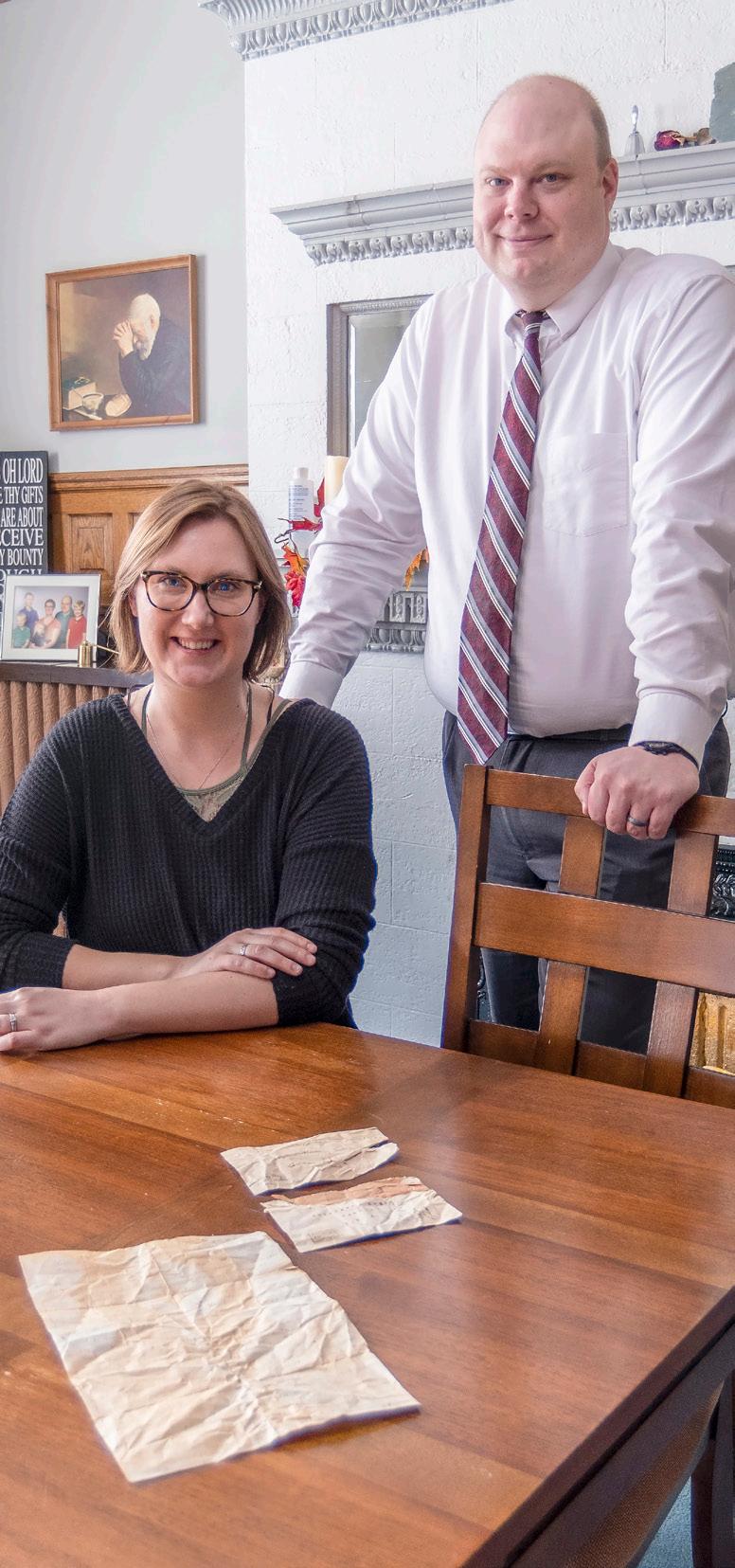
Katie. The lifelong Aberdeen resident, and self-admitted Aberdeen history buff, connected with the American News to share the discovery. She also made a profile to find out more about the Huebls on ancestory.com and connected with Ginny Lewis, professor of German at NSU, who translated Alfred’s letter into English.
The Scotts and their four children have lived in their home since 2015. A literal dream come true, as Katie grew up nearby and says she had always hoped to live here. According to A Souvenir of Aberdeen The Railroad Hub of the Dakotas , their house was first built in 1904 for Judge A. W. Campbell, one of the area’s earliest circuit court judges. After the Campbells, the home belonged to the Julius and Carrie Huebl family. In his obituary, it states that Julius was born in Vienna, Austria, and emigrated to the United States at 19 years old to join his twin brother and another brother in Minnesota. He later married Carrie (Erdmann) and the two eventually moved to Iowa and then Aberdeen, where
they ran the Huebl Funeral Chapel for many years (now the Spitzer-Miller Funeral Home). Dr. Albin Janusz and Aberdeen’s only female mayor, Del Janusz, moved into the residence after the Huebls, where they raised 10 children together until it changed hands to the Scott family.
The letter the Scotts found in the home brings up a lot of questions. For one, how did it get into the floorboards in the first place? By accident? Or by someone placing a time capsule there on purpose? It’s likely the former, as the envelope was presumably repurposed as a grocery list






by Carrie Huebl, where a list for things like Kool-aid, butter, coffee, bread, and bacon is written in her hand. Katie says the Janusz family also did remodeling work on the kitchen in the early ’70s. Was the letter missed then? Or perhaps found and kept where it was for another reader to uncover later on?
Thankfully, with the help of Julius Huebl’s family, the Scotts have also uncovered a lot of answers too. Julius’ great-great-nephew, Larry Moran of Maryland, wrote in an email to Katie that Alfred was the grandson of Julius’ brother Adolf. He says Alfred survived the war and went on to marry in 1954 and have two sons (plus grandchildren). He permanently settled in Mecklenburg, Germany, where he would be in his ’90s (Larry was unsure if Alfred was still alive today). In an email, Larry explained,
“The reason he [Alfred] was interred in a camp after WWII is that he was forcefully removed from Czechoslovakia. It was known as the German Expulsion. After the Russians liberated Czechoslovakia, the Czech partisans rose up and dispossessed the German populace of their land and personal property. Then, the Germans were told to march to the border into Germany or Austria—with literally the shirts on their backs. The camps were really refugee installations and also clearing houses to make sure that no Nazis were trying to slip by undetected. So, when he was free, Alfred needed to rebuild his life and he reached out to the American Huebls for assistance. Cash was not allowed, only foodstuffs and clothing.”
For the Scott family, uncovering Alfred’s story has deepened their love for their old house even more. Katie says, “I always wanted to live in this house, and when it came for sale we knew we wanted to buy it and keep it up. We love living in this neighborhood and living here.” //
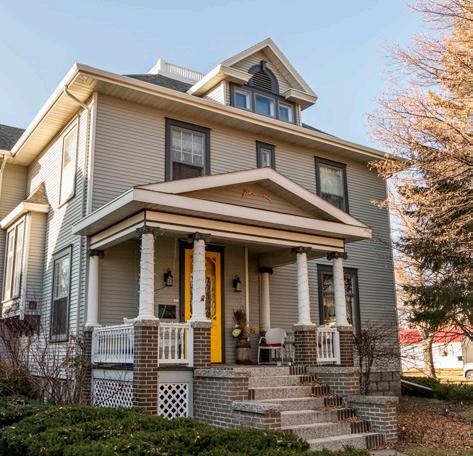 The Scott Family’s home on Jay Street was built in Aberdeen in 1904 and has only had a total of four owners.
This close-up shows the letter Alfred Jenisch penned in German to his aunt and uncle, Julius and Carrie Huebl of Aberdeen.
The Scott Family’s home on Jay Street was built in Aberdeen in 1904 and has only had a total of four owners.
This close-up shows the letter Alfred Jenisch penned in German to his aunt and uncle, Julius and Carrie Huebl of Aberdeen.
Antiques have the unique capacity to capture moments, trends, and personal memories from the past. Although each store defines their “antique” aging differently, officially an antique is over 100 years old, and anything less is termed a collectible, with vintage usually meaning 25 or more years past. Those looking for special items from decades past can find an assortment across Aberdeen sold by knowledgeable vendors as unique as the items they provide. //
by JENIFER FJELSTAD Cheryl Nelson, Andy Heinze, and Dale Fliehs each have their antique specialty at Gold N Gems downtown, which sells jewelry, military memorabilia, coins, and assorted antiques of more than fifty years old. “We’re kind of like three entities under one roof,” Cheryl says.

Cheryl specializes in crafting jewelry into bold, Southwestern style and selling authentic stones believed to have healing powers. Andy finds inspiration in historic coins, some dating back 2,000 years. Dale’s expertise concentrates on military antiques from WWII in the European theatre and stretches to antique toys and weapons. “You never know what’s going to walk in off the street,” he says. The three co-owners say their antiquing interest falls with the knowledgeable clients, who form a community gathering in Gold N Gems. “So, we get to learn every day too,” Andy says. They urge people to not throw things away, but to instead research the item to learn its value.
303 S Main St. 605.262.0952
The two side-by-side buildings making up Southern Shack Designs hold decorative items new and old. Antique, vintage, and collectible items are featured alongside designs the owners Lynne and Mike McCafferty have refinished into modern, colorful styles. “We try not to take away from its history and its story,” Lynne says.
JR’s Furniture and Antiques, owned by JR and Deb Wood, is a mix of antique, used, and retail furniture with blue tags signaling antique or used finds. Antique dishes and knick-knacks stage larger furniture pieces and are displayed on shelves alongside the open showrooms.“The antiques bring quite a variety to the store,” JR says.
JR’s roots in antique auctions led to the store’s mixed selection, and as Deb explains, she still buys whole estates to sell through JR’s.
JR and Deb both recognize that people use antiques most often for DIY projects while they reminisce on their auctioning days, and JR says the difference between selling antique and retail is that antiques are more of a “treasure hunt.”

Antiques in JR’s selection mean the shop offers options for everyone, and if the desired item cannot be found in the store, they likely have it in their nearby storage space.
715 6th Ave SW 605.229.3789
Lynne calls the shop a “collaboration” between different vendors who work as a team to support each other as small businesses. One team member, Keith Richter from K & K Collectibles, says the value in antique, vintage, and collectible items comes from the memory preserved either from his own childhood or from the history of the piece.
Southern Shack also offers refinishing services to anyone who already has an antique, vintage, or collectible piece that needs some care.
312 6th Ave SW 605.377.4239
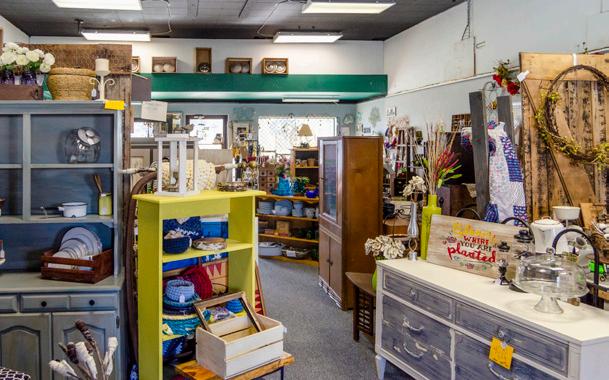
Behind the country-western retail of The Hitch’n Post, jewelry, dishes, knick-knacks, and books line the shelves of the antique and collectible shop in the back of the store. The shop, which is open seven days a week, is made of booths from different local antique vendors, according to Hitch’n Post owner Terry Larson. “They can have their own antique shop without being there 24/7,” he says.
Since the booths are stocked and maintained by individual vendors, each booth’s selection reflects the unique personality of each vendor and the selection is widely varied. Some current vendors participated with the original antique shop started by Larry Lorenzen and Sandy Hunstad almost 20 years ago. Terry says the antique shop brings people to the store who may not otherwise come, and then, they fall for the building’s old, western charms. “We’ve kept it old,” Terry says about the decor style and building.
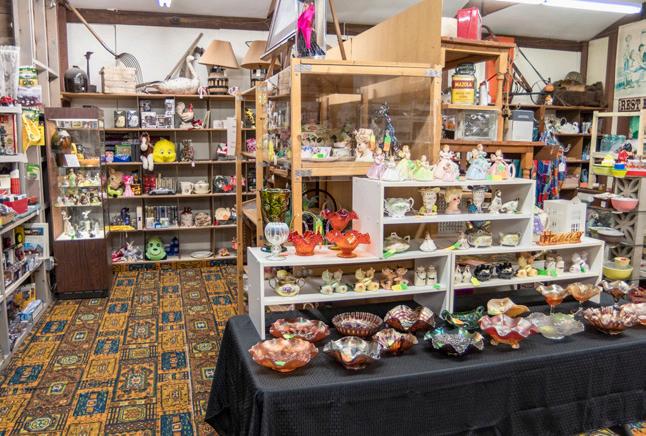
The original Hitch’n Post sign is featured in the antique shop to commemorate the history of the business.
2601 6th Ave SE 605.229.1655
Mother-daughter duo Susie Kroupa and Abby Murano, owners of Junque Shack, may label their items “junk,” but the items for sale have often been scrubbed, waxed, sealed, and reimagined into trendy decor for modern homes.“So, your imagination is just always going,” Abby says.
Junque Shack celebrated its 10th anniversary in 2019 of collecting antique and vintage items especially in farmhouse style or neutral black, white, and gray colors, which Abby says are her favorite styles but adds the store keeps variety for anyone’s tastes.
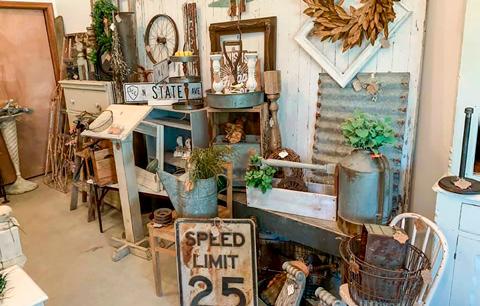
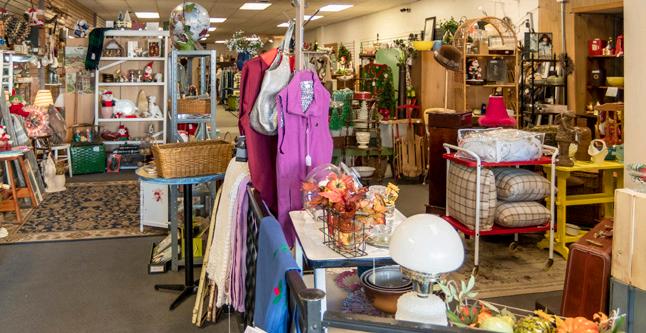
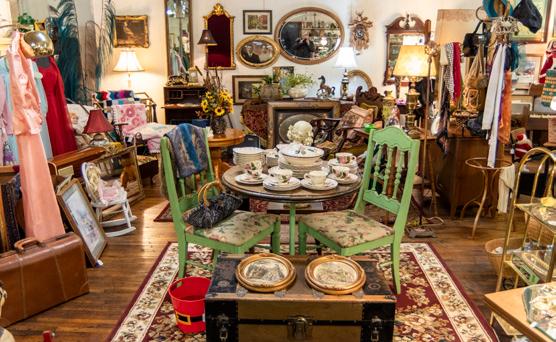
“The different ideas of how you can decorate with it, like for Christmas or for the spring or you can plant in it or you can display your dishware on it,” Abby says. “I would say that’s what’s unique—and fun—is how is this piece going to be pictured into the end game?”
The shop is open about once a month, and Abby said ‘junk’ on the surrounding sidewalks is the signal the shack is having a sale.
422 S Illinois St Suite 3 605.622.0605
Upon entering Bourdon’s Antiques, customers and children are sure to recognize the friendly greeting by the 7-year-old small dog Mango. From there, the shop expands from larger furniture and decorations into artistic items, such as cameras, instruments, and records, toward the back with kitchen items, toys, and rustic tools. “It’s one of those businesses that you can get an array of anything, and I like that,” owner Lynn Bourdon says. “You’ve got to buy whatever is there because—of the many people that do come through here—everybody is looking for something different.”
Red’s Market furthers the eclectic nature of Red Rooster Coffeehouse and draws new people to the unique downtown location, which acts as a coffee shop, event and performance venue, used bookstore, art gallery, and antique shop. The market to the right inside the main entrance displays antiques and a few handmade items of over a dozen individual vendors. “They each have their own aesthetic, taste, and what they like, so they set up their booth accordingly,” co-owner Dan Cleberg says. “So, you get these different personalities as you walk through the place.” Vendors’ vibes range from repurposed home decor to retro pop culture items to salt and pepper shakers. “The cool thing about them all is they have a passion for finding those cool things out there and then sharing them with other people,” Dan says.
Dan adds Red’s Market represents a milestone for the Rooster because on trips with his co-owner and sister Kileen Limvere, they often searched for coffeehouses and antique shops, so adding the antique section represents their personal character as well as that of the Rooster.
218 S. Main St. 605.225.6603
The store was started 40 years ago by Lynn’s mother, and Lynn often worked there throughout her life. Resulting from years of collecting, Bourdon’s Antiques has a little of everything. Recently, Bourdon’s has taken on a newer selection of modern home decor items to complement the older items dating back to the ’30s. Open seasonally April/May through December. Call for details.
38497 133rd St 605.228.9821
This year, women all over the country celebrate the centennial of Women’s Suffrage. Almost 40 years before that day in 1920 when women finally won the right to vote, Matilda Joslyn Gage, an instrumental suffragist leader, was advocating for the movement in Aberdeen and all of Dakota Territory.
n the summer of 1883, 57-year-old Matilda Joslyn Gage left central New York State and boarded a train for Dakota Territory. As the train rambled on, her view gradually changed from forests and rolling hills into fields of wheat and corn as far as she could see. Finally, reaching her destination, she stepped onto the unpaved streets of Aberdeen, a bustling frontier town with waves of new settlers and supply deliveries arriving daily by railroad.
It had been a long trip west, and the temperatures in Dakota were spiking in the upper 90s that summer. Matilda’s lodging in Aberdeen was an unfurnished apartment above the Beard, Gage & Beard Merchandise Store. Her door, and the only thing separating her from passersby strolling along the corner of Main Street and Third Avenue, was a blanket, and her washstand, a simple dry goods box. Above her, exposed rafters hung visible in the ceiling. The modest living quarters stood in stark contrast to Matilda, who always wore elegant dresses and stylish attire fit for a lady of her time.
Still, she was more than happy to be in Aberdeen. Her son, Thomas Clarkson, part-owner of Beard, Gage & Beard, caught “western fever” in years prior and had relocated here with a group of friends from New York, as had her daughter, Julia, who was living on a homestead near Edgeley. But it wasn’t just family that brought Matilda to Aberdeen. It was a fight she had already been battling for most of her life. But let’s back up to the beginning.
by JENNY ROTHTo say Matilda grew up in a progressive household would be an extreme understatement. Even when she was just nine years old, her parents allowed her to stay awake late into the night while they welcomed visitors into their central New York home. Some were slaves escaping to freedom in Canada, as the family’s house was a secret stop on the Underground Railroad. And, according to Born Criminal Matilda Joslyn Gage, Radical Suffragist, other welcomed guests included “Famous abolitionists, philosophers, and politicians” who gathered in the parlor to discuss “ideas that were outrageous for the time: outlawing slavery, granting women rights equal to those of men, and outlawing alcoholic beverages (the temperance movement advocated this move to overcome problems caused by drunkenness).” While most children were ushered out of these adult conversations, Matilda was encouraged to chime in with her own opinions and questions. Later she wrote, “I think I was born with a hatred of oppression, and, too, in my father’s house, I was trained in the anti-slavery ranks.”
“I think I was born with a hatred of oppression, and, too, in my father’s house, I was trained in the anti-slavery ranks.”

Growing up, Matilda also spent time with her aunt Perry, who owned a store and traveled to and from New York City to purchase goods for the business. Working this type of job while married, as well as traveling alone, were radical lifestyle choices for a woman at that time. Watching her aunt, Matilda determined she too would earn her own money by following in her father’s footsteps and becoming a doctor. The only problem? Women weren’t allowed to attend medical school. Nevertheless, Matilda decided to enroll in a secondary school, with hopes that the regulations prohibiting women to study medicine would be lifted. In 1843, she completed her coursework at the Clinton Liberal Institute. She was ready to study medicine, but even with her father’s efforts and connections in the field, not a single medical school would accept her based on her gender.
The blow was deep. Matilda knew she had to do something to make sure other women, someday, would be permitted to study and practice medicine. And there were several more laws that troubled her even more. Women couldn’t own property, vote, or even have rights to their children if their spouse died. While these laws made others feel helpless, they only fueled in Matilda a tireless pursuit to change them.
It wasn’t long after that Matilda married store owner Henry Gage. The couple had
four surviving children, Helen, Thomas Clarkson, Julia, and Maud, as well as one famous son-in-law who we all know as L. Frank Baum. In 1848, a group of suffragists hosted the Seneca Falls Women’s Rights Convention. Matilda opted to stay home and care for her young children instead of attending, but she continued to follow the movement closely in the newspapers while also maintaining her home as a safe place for runaway slaves.
Then in 1852, with her daughter Helen in tow, Matilda decided to in her own words “publicly join the ranks of those who spoke against wrong” by taking part in a women’s rights convention in Syracuse, New York. Also in attendance for her first convention was 32-year-old Susan B. Anthony. While many voices spoke that day about what women could do if only given the right, Matilda took a different angle. In her speech, she told of the many accomplished women artists, scientists, inventors, and leaders throughout history. She dismissed the argument that women had further to go in order to be equal members in society as men, and therefore capable of voting, and instead showed how women had already proven their adeptness time and again. She ended her speech by crying, “Onward! Let the truth prevail.” Most newspapers condemned the event. But 26-year-old Matilda was just getting started.
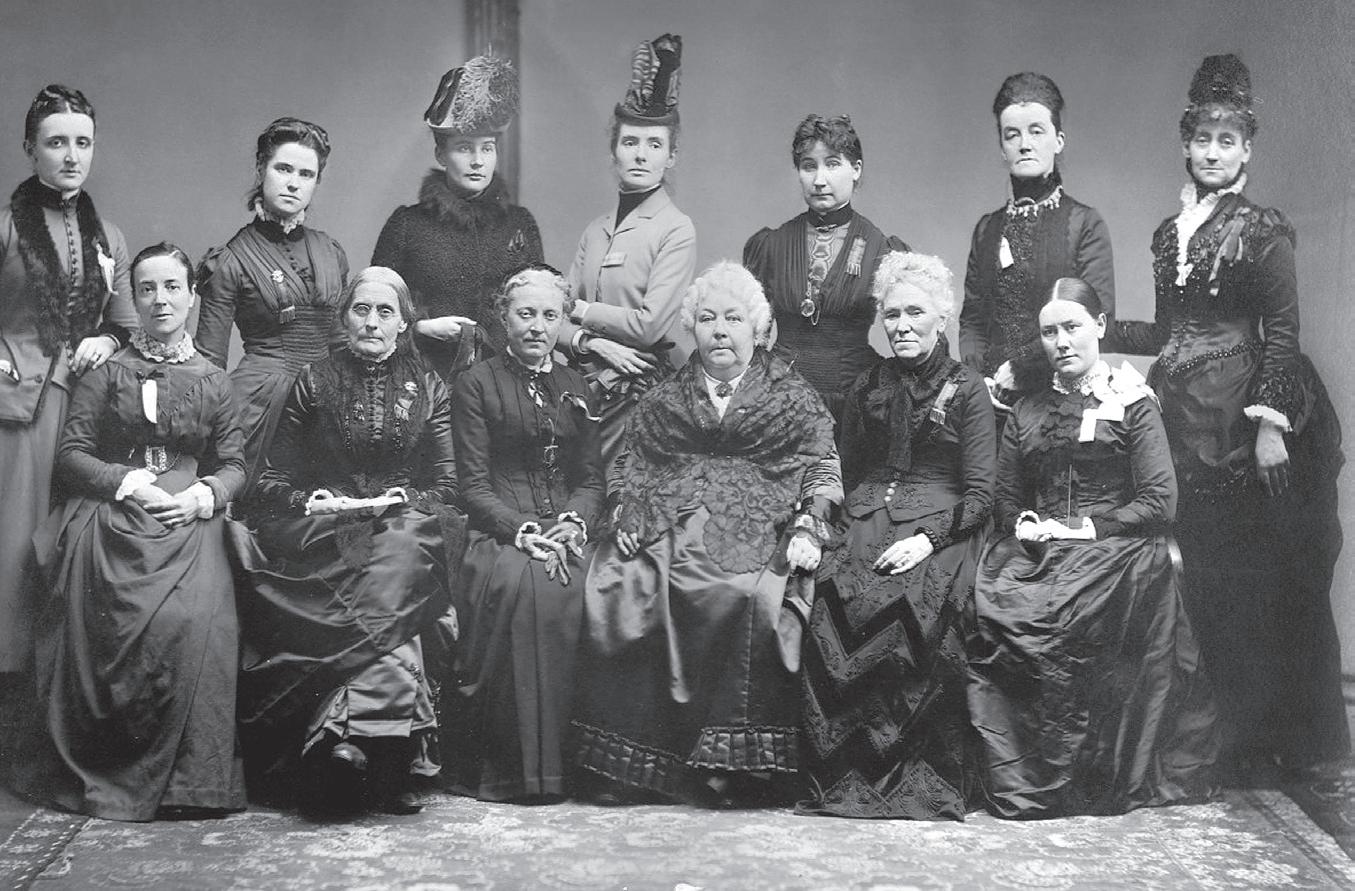
Up until her death at age 71, Matilda
worked to secure equality for women, African Americans, and American Indians. She traveled to speaking engagements and collected signatures for petitions. She led civil disobedience movements and addressed congressional committees. She was a respected scholar and an essential organizer of suffrage associations. Perhaps her greatest gift to the cause, however, was her ability to write. Matilda penned countless letters and articles to newspapers and elected officials, presenting sound arguments for why women should be allowed to vote. Later, she would go on to publish her own newspaper, co-author History of Woman Suffrage with Susan B. Anthony and Elizabeth Cady Stanton, and author her own book Woman, Church and State.
Because of the work of Matilda and other suffragists in the territory, women in Dakota almost won the right to vote.
When Matilda arrived in Aberdeen for the first time in 1883, Dakota Territory was preparing to divide into two separate states. Her mission? To ensure women’s rights made it into any new state constitutions. Laws in Dakota stated that a husband was “head of family” and that his wife had no rights to his land, even in the event of his death, or any claim to the homestead that she had helped build with an equal amount of sweat and tears. Matilda traveled throughout the territory, which proved difficult due to the large distances between towns, giving lectures and encouraging women to act now in their demand for equal treatment and rights at the voting poles. In a letter addressed directly to the Women of Dakota she said, “You have not been permitted to help make these laws which rob you of property, and many other things more valuable. Many women are settling in Dakota. Unmarried women and widows in large numbers are taking up claims here, and their property is taxed to help support the government and the men who make these iniquitous laws.”

Because of the work of Matilda and other suffragists in the territory, women in Dakota almost won the right to vote. But note quite. According to A History of Woman Suffrage Volume III, in the last legislature of 1885, Major John Pickler introduced a bill that gave women the vote. It easily passed in the House and the

Council, but was later vetoed by Governor Gilbert A. Pierce. An effort to overturn the veto failed. Later, in a letter to Matilda, Major Pickler addressed the governor’s veto, stating, “I deeply regret that he did not rise to the grandest opportunity of his life, but he failed to do so.”
Matilda visited Aberdeen on many more occasions throughout her life. All four of her children lived here at one time, and two, Helen and Thomas Clarkson, are buried at Riverside Memorial Park. Some of her grandchildren grew up in Aberdeen as well, including a granddaughter named after her, Matilda Jewell. The Gage house, owned by Thomas Clarkson and later Matilda Jewell, still stands in the Hagerty-Lloyd Historic District today. Matilda often stayed here while visiting family in Aberdeen.
Women did not earn the right to vote during Matilda’s first visit to Dakota, but her work was not in vain. Today, her writings and lectures are referenced by human rights advocates worldwide. She was decades ahead of her time in speaking against the wrong treatment of all people, and because she had the strength to keep going, even after being told “no” time and again, the rest of us can replicate her courage in the face of adversity. Her motto lives on. “There is a word sweeter than mother, home, or heaven—that word is liberty.” //
Matilda Joslyn Gage may not be a household name when it comes to women’s suffrage, but she should be.
There is a saying that “Half of writing history is hiding the truth.” If you’ve never heard of Matilda, it’s likely because her face wasn’t the one you saw in photographs of women marching in the street and getting thrown into jail while trying to vote. Matilda was arrested for registering to vote, but her voice for women’s rights came through the most in her writing and in her many speaking engagements. It is also possible that you’ve never heard of Matilda because her colleagues Susan B. Anthony and Elizabeth Cady Stanton, in a sense, wrote her out of her own story.
Matilda was outspoken in her beliefs on how the Christian church oppressed women and on her support of the separation of church and state. Many of her fellow activists felt uncomfortable with this and worried her views were damaging to the movement’s credibility. Both Ms. Anthony and Mrs. Stanton outlived Matilda, and in writing the history of women’s suffrage, they left her name off articles she authored, failed to give her sufficient credit in all instances she deserved, and downplayed her influence. When women finally won their right to vote in 1920, Matilda had already passed away over 20 years prior.
The good news is history can always be rewritten. Sally Roesch Wagner, an Aberdeen native and a pioneer in women’s studies, has collected research on Matilda for over 50 years. She also opened the Matilda Joslyn Gage Foundation in Matilda’s hometown of Fayetteville, New York (matildajoslyngage.org). Here, visitors can tour Matilda’s home and learn about her legacy. In 2018, the South Dakota Historical Society Press published Angelica Shirley Carpenter’s book, Born Criminal Matilda Joslyn Gage, Radical Suffragist, a work that further solidifies just how much Matilda did for women's and human rights everywhere. And, right here in Aberdeen, an exhibit replicating Matilda’s parlor in New York is set up in her honor for patrons to visit anytime at the Dacotah Prairie Museum.
Before L. Frank Baum moved to Aberdeen, he would stay with his wife’s brother, T.C. Gage, who built this house in West Hill around 1887. Gage was an Aberdeen pioneer and together with two other developers, created the West Hill Subdivision of Aberdeen. Matilda Joslyn Gage would also stay at this house every winter, as would Susan B. Anthony when she taveled through Aberdeen. Remarkably, the house is still standing on the west end of Third Avenue S.W. but it looks a little different. Matilda (front row, second from right) was a lead organizer and speaker at the first International Council of Women in March 1888. The eight-day conference packed the Albaugh’s Opera House in Washington, D.C., to its full capacity of 1,891 seats and included delegates from at least eight different countries. Also pictured are Susan B. Anthony (first row, second from left) and Elizabeth Cady Stanton (front row, fourth from left). Photo courtesy of Britannica.com.This time of year it can be tempting to stay inside in your pj’s until May, but don’t do it! There is so much magic that can only be found in winter. We challenge you to grab your significant other or a group of friends, get dressed up, and beat the winter blahs by having a glamorous night out on the town. Go dancing, drink champagne by candlelight, and eat delicious hors d’oeuvres. After all, the snow is sparkling, and as the saying goes: If you can’t beat ‘em, join ‘em. Here, Brides N Belles shares looks that will leave you glowing. //
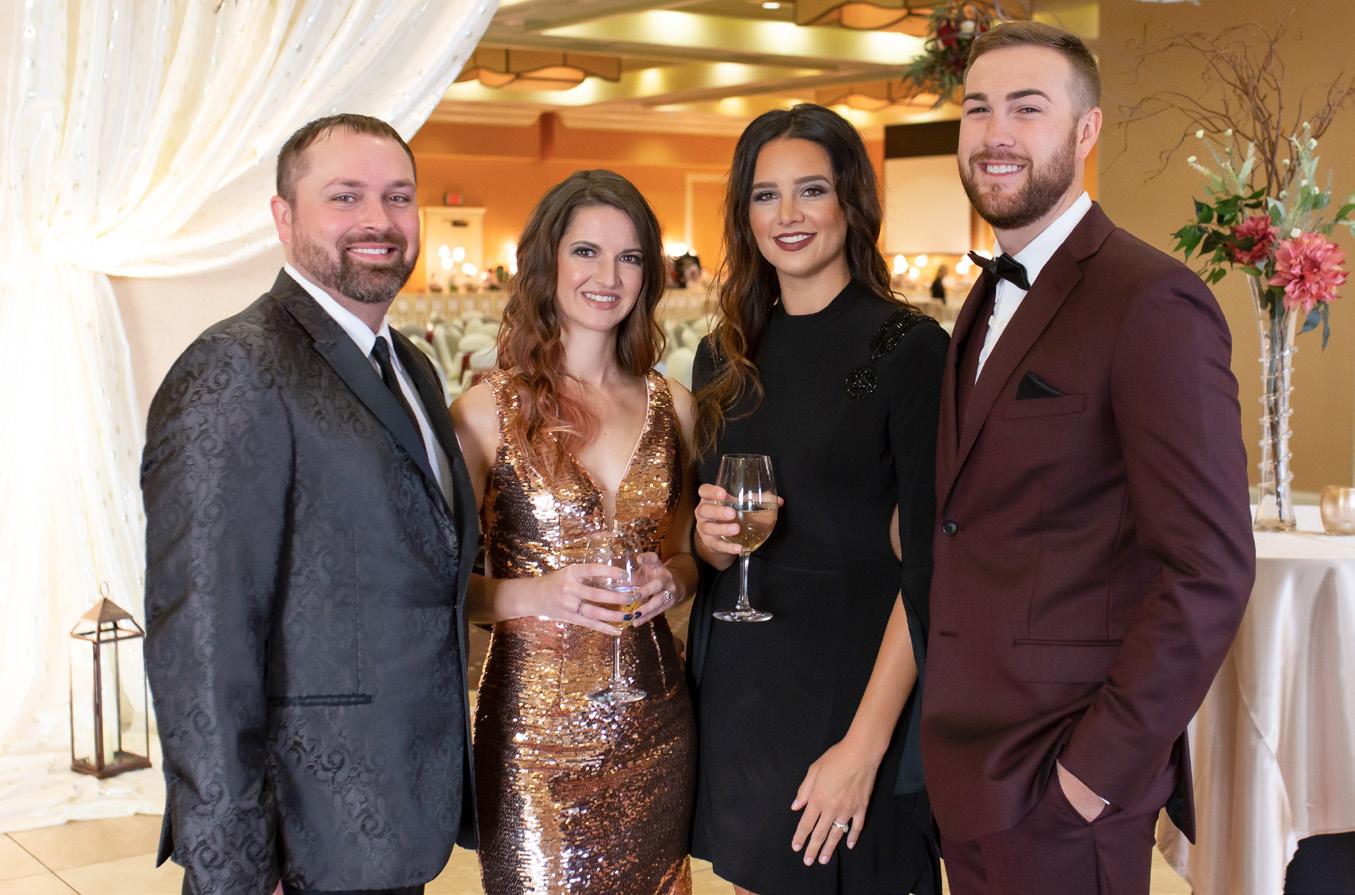
Maddy in an elegant dress with bell sleeves, an open back, and beading on the shoulders.
Dylan in a burgundy Kenneth Cole slim fit tuxedo with a notched lapel.

Kami in a rose gold fitted sequined dress. Perfect for any winter occasion and comes with a beautiful black faux fur jacket. Dathan in an Ike Behar Asphalt Paisley Chase slim fit tuxedo with a peak lapel.



Maddy in a gorgeous floorlength dress with a fun slit, ruching across the waistline, and iridescent beading.

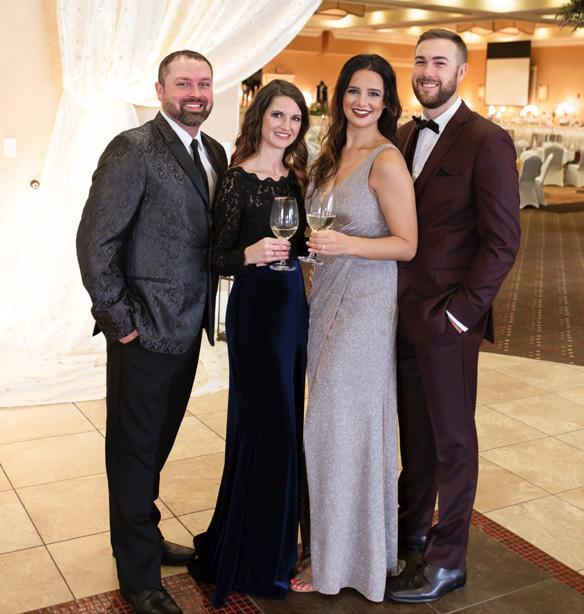
Kami in a two-piece dress with a black lace long sleeve top and a knockout cobalt blue velvet skirt. The pieces can be worn together or broken apart to wear with other outfits.


Melissa’s use of blue creates a striking contrast in the living room and dining room. She describes her design style as traditional with some contemporary touches. The historic home’s trim has been updated by previous owners with white paint which contributes to a modern feel, despite the home’s 110 year old history.

elissa and Danny Kurtz are new to the 110-year-old house at 1215 N. Main. The young couple purchased the house just over a year ago, mainly because of Melissa’s passion for old houses. Danny was particularly attracted to this old house because it was immaculate, and move-in ready. There are a handful of Aberdeen’s historic houses that are in this good of shape. They are rare, and they are spectacular.
Like three others on this part of Main Street, 1215 is situated on a quarter city block. It shares a driveway with the house to the south. The driveways diverge and lead to respective carriage houses toward the back of both lots. The Highlands Development of 1907 promised clean air (from coal burning), quietness (from the trains), and eventual access to the street trolley that ran north on First Street to Wylie.
The house has seen many transformations over the years. Melissa credits the previous owners with preserving and restoring much of the detail throughout. Tage Born and her husband Anthony Hanson owned the house for 20 years. In that time, they did something to nearly every aspect of the house. The most dramatic to the passerby would be the exterior work. New windows were installed, the swimming pool was removed, the entire house was stripped of paint, cedar siding was replaced, and it was painted in a historically sensitive color pallet. They also rebuilt the front porch that was so important to period homes, and missing since they had bought it, and added an attached garage that fits right in. Tage comments that the work was never for the investment, but rather because they wanted to make a comfortable, attractive home for the family of five. She says that they thought they’d live in it forever. However, they recently experienced the empty nest syndrome, and decided to downsize. They passed their passion on to yet one more family in the home’s history.
Melissa says, “We have photographs that have stayed with the house featuring the first owners. We enjoy knowing there have always been lots of kids growing and creating memories in the house. We actually

hosted our wedding reception at our home so we love knowing that we are continuing with that tradition and creating memories of our own in a home where so much love, laughter and life has been experienced.”
The most striking aspect of Melissa’s decorating is the punch of blue in the living room and dining room. It contrasts with the white trim and hardwood floors beautifully. She says her decorating style is, “pretty traditional with some contemporary touches. I love the details in vintage pieces so I have filled the house
It is presumed this house on north Main – within the Highlands Historic District – was built by George N. Williamson. It was built in 1909 for George’s growing family. He and his wife May raised four children in the house. George was a prominent attorney and together with May, very active in the community, their church, and a variety of business concerns. George loved gardening and many flowers from his garden adorned the interior of the house for his oldest daughter’s wedding in July 1923. Three months later, George would unexpectedly die in Rochester, MN, where he was originally from. He was 57. The Williamsons have a family burial plot at Riverside Cemetery. Top: a 1988 real estate brochure featuring this house without a porch on the cover.

with several pieces, dating back to even a century old. Most of the newer pieces are repurposed with paint.” She says they only added a few personal touches once they moved in. Fortunately for them, Tage and Tony removed wallpaper from nearly every wall in the house and many of the ceilings. There is no doubt that there is a certain type of person who can love an old house. One can love it to the extent that they spend 20 years restoring it, while others can love it as a restored Aberdeen landmark for a young growing family. //

The Kurtz Family are the newest owners of this passionately preserved Aberdeen historic treasure. photography and story by TROY MCQUILLEN



Blue is definitely the accent color of the first floor. Antique and repurposed furniture provide interesting texture that support new and vintage accent pieces. The doorknob is an example of the details and craftsmanship featured throughout the house.
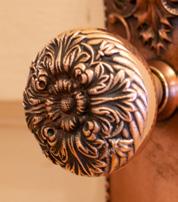


Tage Born says they replaced all the windows in the house and remodeled/updated nearly everything when they owned it. Melissa says this second floor den (below) and one on the main floor, are her favorite places to hang out.

The kitchen is spacious and adorned with new Arts and Craft cabinetry and granite countertops. Despite everything Tage Born’s family restored in the house, they never got around to refinishing the floor in the kitchen. A writing nook was added to the kitchen (below right).
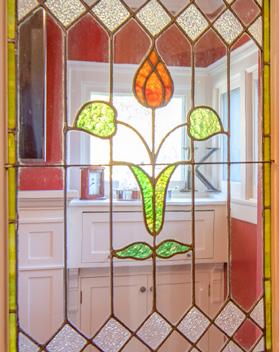
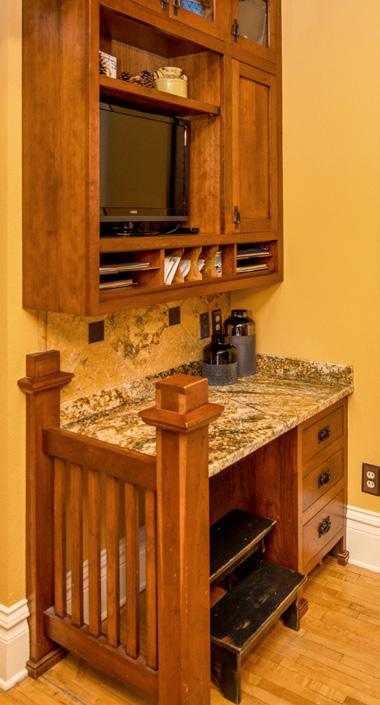


At some point in the home’s history, the porch was removed. After Tage Born and husband Tony Hanson bought the house in 1994, they rebuilt it similar to what was there originally as part of a major exterior renovation.


The master bedroom (above left and below) is flooded with light from a large leaded glass window facing east. Melissa says, “The greatest part about living in an older home is by far the character. This is largely in part to the previous owners preserving all of the beautiful parts of this home. My children would probably say a disadvantage is there is no sneaking around on original wood floors, but hide and seek makes up for that.”

Before we dive headfirst into the 2020s, let’s look at how far we’ve come by taking a glimpse of Aberdeen as it was 100 years ago.
by PATRICK GALLAGHERFrom the vantage point of 100 years, the 1920s were often identified by excesses. The Roaring 20s, as the period has often been called, roared perhaps because of pent-up energies from the experience of World War I. Socially and culturally, in economics, technology, and other dimensions, life changed radically. Even Aberdeen saw significant changes ten decades ago.
To be sure, many changes had been developing over time. Prohibition of alcoholic beverages had appeared sporadically in American states before becoming the law of the land. Cars, radio, movies, and other evolving technologies took off during the 1920s as they became broadly available for mass consumption. Art, architecture, music, dance, and fashion changed too, lending another name to the times, the Jazz Age, because of the growing popularity and influence of jazz music. Newly able to vote, women, probably particularly younger women, asserted more autonomy and expressed it in attire, dance, and attitude, making the “flapper” an icon of the age. Before the ratification
of the 19th Amendment in 1920, women’s suffrage had gradually become legal in several states, including South Dakota.
Perhaps as another response to the war, American politics shifted inward. Ohio Republican Warren Harding, elected President in 1920, ran on a “return to normalcy” after the war years. After he died in office, major scandals within his administration emerged. Nevertheless, his Vice President Calvin Coolidge was elected in his own right in 1924. Coolidge signed the Immigration Act of 1924, which radically cut back the relatively open borders that had preceded the years just before WWI. The Indian Citizenship Act of 1924 broadly made all Native Americans
U.S. citizens. The government enacted protectionist economic measures meant to support American industry. Coolidge was succeeded by a third consecutive Republican, Herbert Hoover, in 1928, who would endure the Stock Market Crash in October 1929 and the onset of the Great Depression as the decade ended.
Politically, Aberdeen and Brown County didn’t stray far from the Republican dominance of the state. After flirtations with Progressivism elected some relatively radical reformers in the 1910s, the state and the Hub City area “returned to normalcy” by the time of President Harding’s ascendance. Later in the 1920s, as Republicans came to be blamed for

economic problems, this area was an early elector of Democrats.
Nationally, Prohibition might have had more cultural impact than anything else. The 18th Amendment didn’t become law until 1919, but as in the case of women’s suffrage, South Dakota was ahead of the curve, enacting Prohibition in a 1916 statewide vote. Brown County voted for Prohibition, but Aberdeen was the only city with a population of over 1,500 to vote “wet”—perhaps because the city was already pursuing local option prohibition. Between 1913 and 1915, more than 30 bars in Aberdeen closed, leaving zero. Over the next 18 years, Aberdeen had its share of arrests for illegal brewing and distilling, beer gardens, and “disorderly” houses, as well as drunkenness. In November 1934, after the Federal repeal of Prohibition in 1933, another statewide vote overturned South Dakota’s dry laws. Sales of hard liquor became legal again, and the first license in the state was issued to an Aberdonian.
Economic conditions compounded the deprivations of Prohibition. The agricultural Midwest heard a different roar well before the Great Depression’s “official” beginning at the end of the decade. High international demand and good prices had produced a boom time for farmers during WWI, and many borrowed money for land and equipment purchases. Unfortunately, the wartime bubble burst when European agricultural production returned to normal
and demand for American products dropped. A recession followed, agricultural prices fell, and farmers suffered. Proving that history rhymes, farmers felt that the tariffs meant to protect American products ended up harming them.
To be sure, the decade had up and often frivolous years. It’s only just to quote the late Aberdeen historian Don Artz’s The Town in the Frog Pond, a delightful history of Aberdeen’s downtown. As he pithily summarizes, “In 1925 the United States was in a period of prosperity, progress, mobility, dreams and romance. Almost every day, the front page of the Aberdeen Evening News featured a shapely and talented beauty queen, a glamorous and much-married movie star, a flamboyant and promiscuous heiress, a ravishing and mysterious aristocrat, a winsome and plucky aviatrix, or some combination of these nouns and adjectives, often linked with delicious scandal.” Still, even among good gossip, the writing was on the wall.
During the 1920s, wages rose slightly nationally, although in another rhyme, the wealthier a person was, the greater the income increased. Per capita income for farmers was about a third of the national average. In South Dakota, farm foreclosures reached a high in 1924-25, and between 1921 and 1930, farmland lost 50% of value. The pain spread into towns, and businesses suffered and banks failed. In Aberdeen, retail sales reached $13.8 million
in 1929 and dropped by more than onethird to $8.6 million in 1935.
Well before the infamous bank runs of the Great Depression, upwards of 200 banks closed in South Dakota. In Aberdeen, bank clearings reached about $78 million in 1925 but by 1933 had dropped 70% to $23 million. A 1929 Year Book put out by the Aberdeen American Legion asserted that despite “a general depression through the agricultural states,” “Aberdeen has the strongest group of banks in the Dakotas.” It noted over $8 million in deposits in 1928. A report from 1925, however, had shown deposits at $2 million higher, and by 1931, only two of the banks in the 1925 report were still operating. Notoriously, the Brown Brothers bank opened on Main Street in 1927 and was quickly bankrupted. A few years later, someone blew up the monument at the Brown family burial plot in the city cemetery.
Before all that, downtown Aberdeen roared with businesses. In the 1928-29 Aberdeen City Directory, Don Artz counted more than 60 businesses in just the block of Main Street between First and Second Avenues. During the decade, the Alonzo Ward Hotel was rebuilt after a fire, and the Capitol Theatre opened. St. Luke’s Hospital also opened a new building. Some nationally known businesses came to town too, including J.C. Penney’s and Sears, Roebuck and Co. Woolworth’s opened in 1926 with a feature new to the area: a
By 1928, there were 8,000 cars in Brown County. Many gas stations and auto dealers popped up on Lincoln Street in the Downtown. You might have trouble orienting yourself with this picture. It was taken in 1926 and not much in it exists today. Imagine standing on Main Street, in the big empty lot west of Geffdog, looking northwest at the intersection of 6th Ave and Main Street. The smokestack is from Tiffany Laundry. The filling station on the left is Swanson Service Station and it is on the same spot that Kusler’s is today. The building with cars parked along the side (this is 6th Avenue remember) is Durant Auto selling Star Cars. This building doesn’t exist and it’s about where Dominos Pizza is located. There is actually a vacant lot right on that corner where it stood that Dominos uses for parking. The building with the sign in the distance on the right that says Wilson Undertaker was recently lost in the Malchow’s fire. The building to the south of the Wilson building is the Chamber of Commerce building that is still being used.

luncheonette. While common in the store’s locations in larger cities, Aberdeen’s was apparently the first in the Dakotas.
Railroads were still dominant in the Hub City in the 1920s. Some 700 people— equal to about one in every six adult men in Aberdeen, worked for the four railroads operating here. Like, well, spokes coming out of a wheel’s hub, nine lines came through Aberdeen. In addition to freight trains, 22 passenger trains served the city daily. On the other hand, a trolley system in town shut down in 1922 after operating since 1910.
In a sign of times to come, the automobile became more affordable and widely available. In 1928, there were nearly 8,000 vehicles in Brown County, about one car for every other adult. By 1919, some 50 auto-related businesses operated in town, including on Main Street. The store that became Malchow’s once had a turntable and elevator for displaying cars. In 1929, 30% of retail business in Aberdeen was car-related. This was despite the fact that roads in town were starting to crumble. A 1907 surfacing project paved many streets with 1.6 million wooden blocks, which began to crack after heavy rains in the 1920s. People compared streets to the Badlands. In 1934 the city began to resurface streets with concrete.
In 1928, the city dedicated the Tri-State Fairgrounds Airport, the first municipal airport of its kind in the state. Operating only a couple years before the city purchased land for the site of the current airport in 1930, it attracted barnstorming pilots racing cross-country.
In housing, the decade kicked off with a boom in home construction—312 homes in 1920—but that was the last good year in the decade, as later construction focused on business—1928 saw only 56 new homes. The decline may not be surprising: the roaring year of 1920 followed a decade with a population growth of about 4,000 people, while the 1920s only added half that many.
In education, the Aberdeen Public Schools added much needed space, building Roosevelt Junior High, Simmons Middle School, and Washington Elementary. A 1926 report showed that (before Simmons was built) the total enrollment of 3,159 students was about 200 above capacity.
The city’s one college at the time saw swings and milestones. The Memorial Archway went up in 1920 at the north entrance of the then Northern Normal and Industrial School. Although the governor vetoed a legislative name change to Northern State Teachers College in 1924, Northern started to adopt the new name anyway. Enrollment fluctuated significantly.
From about 600 students in 1920, it increased more than 50% to 947 in 1925— the highest until the 1950s—then dropped to around 800 at the end of the decade. Tuition more than tripled in the 1920s— from $20 for a full year in 1922-23 to $70 in 1930-31. Another landmark occurred in 1923 when, after no student responded to the president’s offer of a dollar to name the team, the men’s basketball team chose “Wolves” as their mascot.
Several dance halls in Aberdeen and around the county, including a couple upstairs on Main Street, offered music and entertainment. The downtown also hosted six movie theaters, which might have shown 500 movies in a year, as well as theatrical productions.

Aberdeen’s high school track team won the state title in 1927 and was the runnerup in 1924. NSU’s men’s basketball team won their conference title in 1924 and played their first game in the new Spafford Hall gym in 1925. Amateur baseball, trapshooting, and tennis, among other sports, took off. After a few failed attempts, the YMCA opened in Aberdeen in 1926. The M meant something: it was only for men and boys, except on Tuesdays when women and girls could exercise there.
Aberdeen offered about 20 churches in the 1920s. In addition, many civic organizations offered citizens a variety of opportunities for getting involved and for what would come to be called networking about 60 years later. To stay informed, the community offered three daily newspapers, a weekly, and other regular publications.
That 1929 American Legion Year Book offered a cogent assessment: “Business conditions were registered as normal or to about 5% above, again demonstrating that our community has become so firmly built up that temporary conditions cause no particular fluctuation in business conditions one way or the other.” A similar attitude that national circumstances don’t have much effect here—we never get too high or fall too low—seems to prevail today, one that somehow balances humility and pride. Within a few years of 1929, however, after thrashings by the economy and Mother Nature, South Dakota would have the highest proportion of people eligible for relief in the nation. Entering the 2020s, one wishes roaring economic debacles would be a decade behind, not ahead.
Though history may want to rhyme, let us hope it won’t this time. //
WWhen asked what the biggest difference in Aberdeen is since 2010, Sheila Richards, chair of the Aberdeen Area Diversity Coalition, told a story:
“One day last summer, I was shopping at Walmart. As a person with limited mobility, I really appreciate the electric carts. I had stopped in the yogurt aisle but was unable to spot what I wanted. A young, nimble Asian woman came to me, “Can I help you?” I explained what I wanted. She climbed, yes she did, up onto the shelves but alas could not find “my” yogurt. Later, tooling along in broccoli and fresh green beans, I felt a tap on my shoulder. It was my new friend, smiling, holding three containers of the yogurt I wanted. “Look, I found it.” A Hispanic family was in front of me at the check-out. Mom, dad, and two cute little kids. Dad asked, “Can I help unpack your cart, put things up on the conveyor belt?”
Si, muchas gracias (three of my 100 Spanish vocabulary words). The cashier was a young Somali woman wearing a hijab. I asked for carry-out help. Help arrived—a tall young man with a traditional braid down his back. Now,
The year 2020 won’t get the attention its 20-year-old sibling did. Without the millennial overtones, Y2K.2 is less auspicious, but the year 2000 didn’t really have much on 2020. After all, in 2000, most of us knew nothing about smartphones (the iPhone first appeared in 2007). Fax
machines still mattered. YouTube and Facebook were still a few years away. Change is fast.
Aberdeen Magazine surveyed a number of people who are involved in many facets of life in Aberdeen—government, business, education, social service, and more—about their thoughts on the city as we move into the 2020s. They told us what they thought had changed, what they think or hope will change, and what Aberdeen’s strengths and weaknesses are as we enter the new decade. The results were interesting.
Looking back at the past decade, Mike Levsen, mayor for most of that period, ticked off a list of accomplishments, “Ongoing increase of 6,000 additional residents compared to 2004. Over 1,500 added housing units. Every city and NGO public use facility reconstructed, remodeled, upgraded, or with current work in progress, or with plans for change in place. MFG, Demkota, Sanford, AGP, and other service and production employers in place. 3M, Midstates, Avera, ethanol plants, and other existing enterprises expanded.”
Heath Johnson, Dakota Plains Commercial Real Estate, summarized some of the themes that emerged from the survey: “The biggest difference I see in Aberdeen in the last ten years is the large growth in the rental housing market and the changing dynamics of the retail
continued on next page
“Aberdeen’s greatest strength is our community. The most recent example is the Malchow’s fire. The way our community rallied together to support the tenants and the Malchow family almost instantly was amazing. The companies in town that made the transition for the tenants so smooth and the ones that helped support the fire department while they worked tirelessly to put out the fire were some of the most encouraging actions I have ever seen.”
–Alexandra Miller, Journey Home“Our greatest strength is the spirit of self-determination. We have had so many great businesses start and flourish here. We need to capitalize on our legacy of successful enterprise through connecting people, telling our success stories, and by lowering the hurdles of entrepreneurialism.”
–Mayor Travis Schaunaman“I think the biggest strength of our community is that it is a big small town, not a small big town. Aberdeen has always had a “Sometimes you want to go where everybody knows your name” feel to it. It is rare to be in a place that has so much to offer yet still has such a small-town feel.”
–Rodney Johnson, New Life Fellowship ChurchAs we enter a new decade, Aberdeen residents weigh in on our city’s strengths, weaknesses, and hopes for the future.
What would you expect or hope to see happen in Aberdeen in the next decade?
“More affordable housing and keeping landlords accountable to protect renters.”
–Alexandra Miller, Journey Home
“A large scale community strategic planning effort.”
–Dani McQuillen, Bureau of Indian Affairs
“Hoping that the Aberdeen trail system becomes a reality.”
–Tim Weisz, Roncalli Schools
“An event center.”
–Katie Washnok, Blackout, Inc.
“Turning the Mog into a destination (like Falls Park), not a disaster.”
–State Representative Carl Perry
“I would like Aberdeen to proactively make available resources to help those living with dementia and their loved ones. Knowing how to recognize, how to care for, and how to provide support for this pending epidemic speaks to the essence of how a community can unite for a common and worthwhile goal. If we cannot cure it, let’s focus on improving the quality of lives.”
–Nathan Gellhaus, Angelhaus
“I would love to see more options in the winter for parents with small children. The winter is long and painful; any business ventures that would create activities for family fun would be much appreciated.”
–Rodney Johnson, New Life Fellowship Church
“I see Aberdeen as a place where technological advancements can be developed, produced, and put into action on our local farming operations.”
–City Council Member
Joshua Rife
“Generations working together to solve problems, rather than just complaining about them. Things won’t change unless you help to change them.”
–Tom Wanttie, Aberdeen Ride Line
market. We have built lots of new apartments to satisfy the population growth that has been occurring. Retail has changed dramatically from everyone trying to be out on the east side of town, to a better mix of east-side retail and service along with a revitalization of downtown Aberdeen.”
Population changes, business needs, housing, downtown, and other topics were cited frequently by respondents. Starting with the first, City Manager Lynn Lander reported a significant population increase in Aberdeen, “U.S. Census data estimates a population increase of 9.47% to date since 2010.”
Within those numbers, of course, is a literal change in complexion for the city, which Sheila Richards alluded to earlier. Aberdeen has gotten more diverse. U.S. Census estimates for 2017 suggest the white proportion of Aberdeen’s population at 88.8%, down from 92.9% in 2010. The foreign-born population of Aberdeen is estimated at 1,105, about four times the 2010 level, and about 4% of the total population. Interestingly, 100 years ago, the foreign-born population of Aberdonians 21 and over (what the Census measured) was 22% of the total. About 2.4% of today’s Aberdeen population are not

U.S. citizens; in 1920, the proportion was almost 10%. For what it’s worth, at least 20% of the foreign-born a century ago were from countries with which the U.S. had just fought a war and would again within a generation.
Yet, despite noted resistance to some new people in the area in recent years, several respondents saw progress. Presentation Sister Kathleen Bierne identified as a change over time, “The awareness that newcomers to our area are here to stay. I think back in 20022010, folks thought that it was just a temporary experience. The backlash seems to be receding a bit the last year or so as people realize that newcomers are not only here to stay but needed for our economy.” While some noted a need to address resulting cultural differences, no one identified their presence as a threat. The survey revealed concern about business, particularly retail—from a perspective of both online competition as well as a lack of choice. Nathan Gellhaus of Angelhaus urged, “I would really like to see a concerted effort to support our local retail marketplace. I understand the convenience of clicking, adding to cart, and unwrapping a delivered package two days later, but if we all spend more locally, that rising financial tide can lift all ships.” Almost
“ABERDEEN NEEDS TO ADDRESS THE RETAIL OPPORTUNITIES THAT ARE LEAKING OUT OF ABERDEEN. IF PEOPLE VISIT, THEY WILL SHOP. IF THEY CAN’T SHOP, THEY MIGHT NOT VISIT.”
—CASEY WEISMANTEL, DIRECTOR OF THE ABERDEEN CONVENTION AND VISITORS BUREAU The diversity of Abereen will continue to change during the next decade.
directly in response, Aberdeen Housing Authority’s Jody Zueger wants to see “More retailers, so we don’t have to shop online or go outside of Aberdeen.”


Casey Weismantel, director of the Aberdeen Convention and Visitors Bureau, summed it up, “Aberdeen needs to address the retail opportunities that are leaking out of Aberdeen. If people visit, they will shop. If they can’t shop, they might not visit.” Sheila Richards made one blunt assessment: “The mall is becoming a tomb.”
The mall notwithstanding, development on the east side of town was seen positively, but the east side has historically drawn traffic and businesses away from downtown. Our respondents saw downtown as another area of both
concern and opportunity—and necessity. Aberdeen Downtown Association Director Shelley Westra–Heier said, “I’d really like to see additional housing opportunities arise in our downtown area. An increase in people living downtown creates support and a continued push toward full storefronts and a wide variety of retail and service-based businesses in downtown Aberdeen.” Sandra Welling of Presentation College noted, “I have talked to many who said when they were young, downtown was a ‘thriving, happening place.’ I would love to see our downtown become a ‘happening destination.’”
CO-OP Architecture’s Spencer Sommers thinks the downtown needs “more options that can attract people outside of the usual nine to five weekday.
“We do not have good immediate options for people struggling with addictions and mental health issues. People struggling with these issues are sometimes sent to jail for detox, often because the medical facility is at capacity or because they have ‘dealt’ with the person too often. The issue of their addiction is never addressed.”
 –Gina Karst, Safe Harbor
–Gina Karst, Safe Harbor
“Those who see events and changes as to be feared and opposed rather than managed to our best advantage. Most effective change will be when those people are inevitably replaced by younger, more enlightened and more courageous residents. If not, we are doomed to be older and smaller, rather than larger and more vibrant.”
–Former Mayor Mike Levsen

“I think that Aberdeen is at a crossroads, and it must choose which way to go. And it starts with deciding whether to put up a fight to keep living in a monoculture or, the hardest thing, to lean into discomfort and try imagining a community where more mindsets, life journeys, and approaches can mean more solutions. The sin is the illusion that the achievements are exclusively attributable to their hard work and the perpetuation of a public discourse that continues to marginalize many in our community.”
–Ioana Hojda, Northern State UniversityMore places to eat, live, and socialize (all within proximity) will help attract and retain residents of Aberdeen by creating a more vibrant downtown ‘destination’ district. Exterior dining options, wellutilized plaza spaces, and a denser pedestrian population all help create the sense of place that is seen in every successful city throughout the U.S.”
City Manager Lander noted, “179 new commercial buildings have been constructed over the last decade. The city valuation has increased by $550 million for the last decade due mostly to new construction.” Heath Johnson added a specific related hope, “With regards to commercial real estate, I believe that the west end of Aberdeen will finally see its long-awaited revitalization. The greatest driver of this will be the lack of space along 6th Avenue that is already occurring. Businesses will need to push west, and in doing so, will allow for the properties out there to be significantly changed.”
Looking at business needs from a different angle, Aberdeen Development Corporation President Michael Bockorny raised “the continued challenge of not having enough workers to fill open positions. This challenge is not going away and maybe never will, so we have to be creative in our approach.” One solution, Council Member Joshua Rife mentioned, is the role Northern State University and Presentation College offer by providing “Aberdeen with a huge opportunity for trained workers to grow and expand our existing workforce as well as promoting an entrepreneurial spirit in Aberdeen.” State Representative Carl Perry noted a local weakness, “We do have ATEC but no higher education for technical, i.e., a Mitchell or Watertown Vo-Tech.”
Several respondents noted housing improvements in Aberdeen in the past
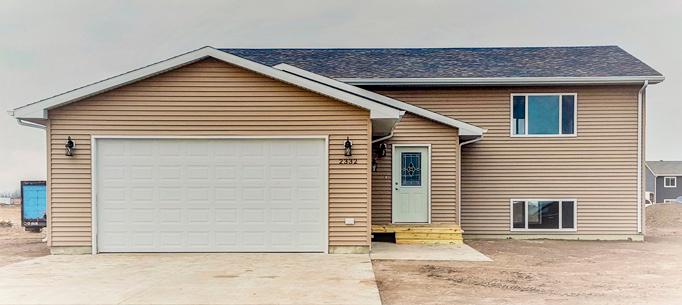

decade. Lander reported the city added more than 1,800 housing units since 2010, an increase of 15%. But it’s not a need that goes away. Jody Zueger, director of Aberdeen Housing Authority, says, “I would like to see more affordable housing and have the City of Aberdeen participate in this endeavor instead of leaving it up to nonprofits to handle.”
Melinda Millermon of Northern State University noted another issue that was reported by several respondents: “I would say public transportation is the greatest weakness here. Parents are having to bring their kids to school in the morning and pick them up, which creates congestion near the schools. Ride Line helps with public transportation, but they are only available limited hours, and you have to call so far in advance to schedule a ride.” It’s not just a school issue. Avera Health CEO Todd Forkel noted that there are “more people who cannot get to their healthcare appointments due to lack of transportation.” Not to mention getting to work or shopping.
ADC’s Bockorny adds, “One of our greatest strengths is our infrastructure, which is key in economic development.

“I WOULD LIKE TO SEE MORE AFFORDABLE HOUSING AND HAVE THE CITY OF ABERDEEN PARTICIPATE IN THIS ENDEAVOR INSTEAD OF LEAVING IT UP TO NONPROFITS TO HANDLE.”
—JODY ZUEGER, ABERDEEN HOUSING AUTHORITY DIRECTOR Homes Are Possible, Inc. continues to develop housing opportunities in Aberdeen. Photos courtesy of HAPI. Industrial park companies, like Regal (Hub City, Inc), are implementing advanced technologies, providing for more careers in technical manufacturing and engineering.
As long as we stay ahead of the curve in continued development and maintenance of the infrastructure, we will maintain a competitive advantage over other communities in attracting growth opportunities.” Still, some respondents pointed to the need for road improvements.
City Manager Lander noted a couple of alarms somewhat related to infrastructure and other city spending: “Nationally and locally elected officials will be forced to consider the loss of former traditional revenue sources to fund continuing road improvements.” He mentioned, for example, that electric vehicles pay no transportation taxes to help finance needed road improvements. In addition, despite the Supreme Court decision allowing the
state to collect sales tax on online sales, “The primary question is will online sales tax revenues truly replace revenues collected by local merchants who also paid local property taxes?”

Addressing these opportunities and threats often involves drawing more people and/or business to Aberdeen, which means promoting the city. Hub City Radio’s Brian Lundquist said he’s been “to many communities our size—some smaller, some bigger—and they ask how does Aberdeen do so well? What’s the secret sauce to Aberdeen’s growth and success?”
Promotion can be an individual thing too. A repatriated Aberdonian, Heath Johnson gave a pretty good endorsement: “I would most like to see more people like me, those

who left for a significant period of time, return to Aberdeen to live, work, and raise their families. Aberdeen is a great place to be, and we should all be recruiting our families and friends to give us another look.”
All in all, our respondents see progress and good things ahead for Aberdeen, but not without some diligence and work. The old saying goes, “Good things come to those who wait”—but these folks would include the often overlooked rest of the statement—”but only what’s left from those who hustle.” Echoing that sentiment, the last words here go to Mayor Travis Schaunaman: “I’d like to see more buy-in from the average citizen. Many of us are excited about our community’s direction, but there are still way too many who are either sitting on the sidelines or are vocally disenfranchised. I want everyone here to begin to be the change we want to see.”
Watch for more Version 2020 stories in the future issues of Aberdeen Magazine that will explore some of the subjects mentioned here in greater depth. //
Respondent affiliations are listed only for identification purposes, not to suggest organizational endorsements. Some comments were edited for space but did not change meaning.
Congratulations to our Aberdeen Public Schools athletes, fine arts performers, and academic achievers.

We have GREAT students and staff, and the Aberdeen Public Schools Foundation is proud to support them ALL!

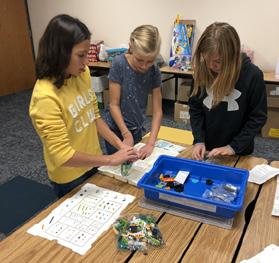
“ABERDEEN IS A GREAT PLACE TO BE, AND WE SHOULD ALL BE RECRUITING OUR FAMILIES AND FRIENDS TO GIVE US ANOTHER LOOK.”
—HEATH JOHNSON, DAKOTA PLAINS COMMERCIAL REAL ESTATE The Aberdeen Mall continues to experience changes in an evolving retail environment.